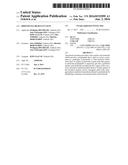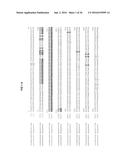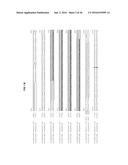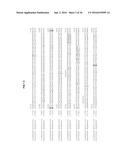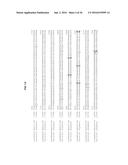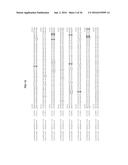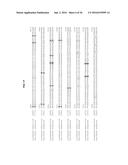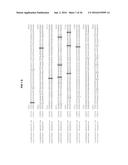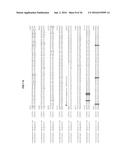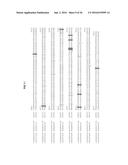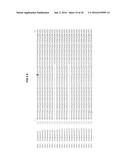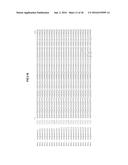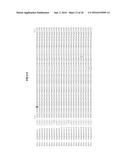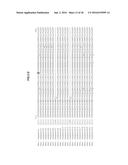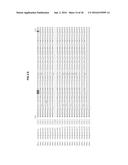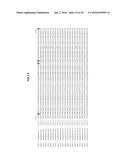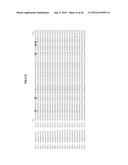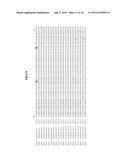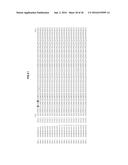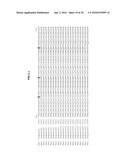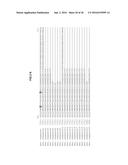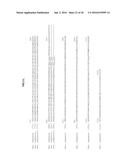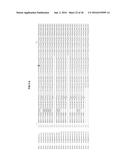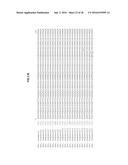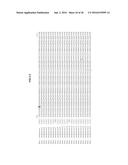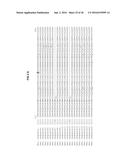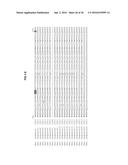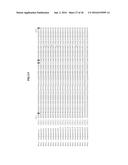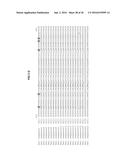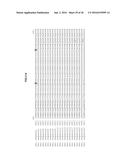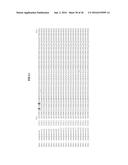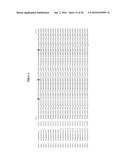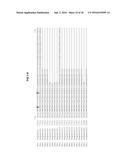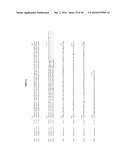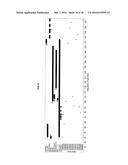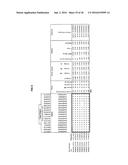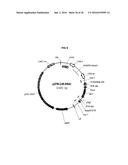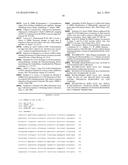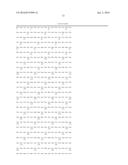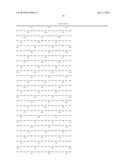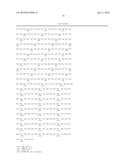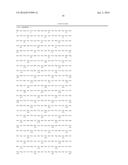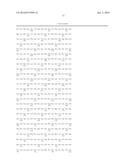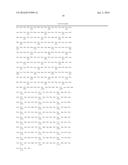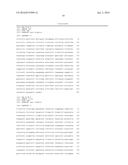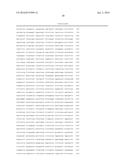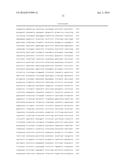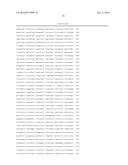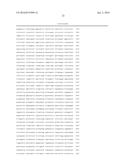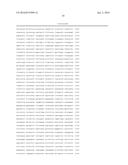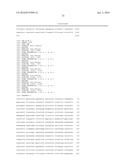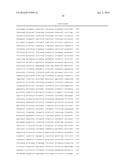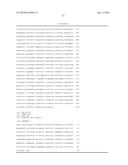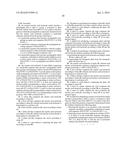Patent application title: RHIZOMANIA-RESISTANT GENE
Inventors:
IPC8 Class: AC12N1582FI
USPC Class:
800279
Class name: Multicellular living organisms and unmodified parts thereof and related processes method of introducing a polynucleotide molecule into or rearrangement of genetic material within a plant or plant part the polynucleotide confers pathogen or pest resistance
Publication date: 2016-06-02
Patent application number: 20160152999
Abstract:
The present invention provides a new nucleic acid molecule which encodes
a polypeptide that is able to convey a resistance to a pathogen, in
particular to "Beet Necrotic Yellow Vein Virus" in a plant, in particular
a plant of the Beta genus, in which the polypeptide is expressed, and
also a preferred nucleic acid molecule encoding the RZ-3 gene of Beta
maritima, derivatives and homologues thereof. Further aspects of the
invention include vectors, transgenic plant cells, transgenic plants,
methods for production thereof, and methods for identifying a
resistance-conveying nucleic acid molecule.Claims:
1-14. (canceled)
15. An isolated nucleic acid molecule which encodes a polypeptide that is able to convey a resistance to Beet Necrotic Yellow Vein Virus (BNYVV) in a plant of the Beta genus in which the polypeptide is expressed, characterised in that the nucleic acid molecule comprises a nucleotide sequence selected from the group consisting of: a) a nucleotide sequence that encodes a polypeptide comprising an amino acid sequence SEQ ID NO: 2 or SEQ ID NO: 3, b) a nucleotide sequence comprising the polypeptide-encoding sequence of SEQ ID NO: 1, c) a nucleotide sequence that hybridises with the complementary sequence of the nucleotide sequence according to a) or b) under stringent conditions, and d) a nucleotide sequence that encodes a polypeptide which comprises a substitution, deletion and/or addition of one or more amino acids as compared to SEQ ID NO: 2 or SEQ ID NO: 3 or to a polypeptide encoded by SEQ ID NO: 1.
16. The nucleic acid molecule of claim 15(d) comprising (i) a nucleotide sequence that encodes a polypeptide which has an amino acid sequence which is at least 60% identical to SEQ ID NO: 2 or SEQ ID NO: 3 or to the amino acid sequence of the polypeptide encoded by SEQ ID NO: 1, or (ii) a nucleotide sequence that encodes at least one nucleotide-binding domain (NBS) corresponding to amino acid positions 168-227 of SEQ ID NO: 2 or corresponding to amino acid positions 182-241 of SEQ ID NO: 3, at least one leucine-rich domain (LRR) corresponding to amino acid positions 591-613 of SEQ ID NO: 2 or corresponding to amino acid positions 605-627 of SEQ ID NO: 3, and/or at least one internal repetitive domain (IR) corresponding to amino acid positions 1013-1072 of SEQ ID NO: 2 or corresponding to amino acid positions 1027-1086 of SEQ ID NO: 3.
17. A vector that comprises the nucleic acid molecule according to claim 15.
18. A host cell that comprises the nucleic acid molecule according to claim 15, wherein said nucleic acid molecule is heterologous to said host cell.
19. A host cell that comprises the vector according to claim 17.
20. A plant cell that comprises the nucleic acid molecule according to claim 15, wherein said nucleic acid molecule is heterologous to said plant cell.
21. A plant cell that comprises the vector according to claim 17.
22. A plant or a part thereof, comprising the plant cell according to claim 20.
23. The plant or a part thereof according to claim 22, which is of the Beta genus but is not Beta vulgaris subsp. maritima.
24. A plant or a part thereof, comprising the plant cell according to claim 21.
25. A seed of a plant, wherein the seed comprises the nucleic acid molecule according to claim 15 as a transgene.
26. A seed of a plant, wherein the seed comprises the nucleic acid molecule according to claim 15 as an introgressed region.
27. A method for producing a transgenic plant cell that comprises the nucleic acid molecule according to claim 15, characterised in that the method comprises a step of introducing the nucleic acid molecule according to claim 15 into the plant cell.
28. A method for producing a transgenic plant, characterised in that the method comprises the following steps a) introducing the nucleic acid molecule according to claim 15 into a plant cell, and b) regenerating the transgenic plant from the transgenic plant cell from step a).
29. The nucleic acid molecule of claim 15, wherein said nucleic acid molecule comprises a regulatory sequence comprising nucleotides 1-1403 of SEQ ID NO: 1.
30. A host cell that comprises the nucleic acid molecule according to claim 29, wherein said nucleic acid molecule is heterologous to said host cell.
31. A plant cell that comprises the nucleic acid molecule according to claim 29, wherein said nucleic acid molecule is heterologous to said plant cell.
32. A plant or a part thereof, comprising the plant cell according to claim 31.
33. A seed of a plant, wherein the seed comprises the nucleic acid molecule according to claim 29 as a transgene.
34. A seed of a plant, wherein the seed comprises the nucleic acid molecule according to claim 29 as an introgressed region.
35. A method for identifying a nucleic acid molecule which encodes a protein that is able to convey a resistance to Beet Necrotic Yellow Vein Virus (BNYVV) in a plant of the Beta genus in which the protein is expressed, characterised in that the method comprises the following steps: i. detecting the absence of an insertion in the nucleotide sequence encoding a polypeptide comprising an amino acid sequence SEQ ID NO: 2 or SEQ ID NO: 3, or ii. detecting at least one polymorphism according to FIGS. 1, 2 and/or 3 in the nucleotide sequence encoding a polypeptide comprising an amino acid sequence SEQ ID NO: 2 or SEQ ID NO: 3 with the use of molecular markers that identify the polymorphism.
Description:
FIELD OF THE INVENTION
[0001] The present invention relates to a nucleic acid molecule that encodes a polypeptide that is able to convey a resistance to a pathogen, in particular to "Beet Necrotic Yellow Vein Virus" in a plant, in particular of the Beta genus in which the polypeptide is expressed. The invention also relates to a polypeptide that is able to convey a resistance to a pathogen in a plant, in particular a resistance to BNYVV in a plant of the Beta genus, in which the polypeptide is expressed and that is encoded by the nucleic acid molecule according to the invention. The invention also relates to a transgenic plant, plant cell, plant organ, plant tissue, plant part or a seed of a plant that comprise the nucleic acid molecule or parts thereof, and also to methods for producing a transgenic plant or plant cell of this type. The invention also includes methods for detecting the resistance-conveying nucleic acid molecule and methods for the selection of plants or plant cells that have the resistance-conveying nucleic acid molecule.
BACKGROUND OF THE INVENTION
[0002] Rhizomania is the most serious sugar beet disease worldwide in terms of profitability and may cause earnings losses of 50% and more. The disease, which is also referred to as "root madness", is caused by the "Beet Necrotic Yellow Vein Virus" (BNYVV) and is transmitted by the soil-borne protozoa Polymyxa betae. A BNYVV infection manifests itself in an increased proliferation of the thin roots and secondary roots and in the formation of a greatly reduced root body with reduced sugar content. Infected plants demonstrate a reduced water uptake and are thus more sensitive to dry stress. When the infection spreads to the entire plant, this results in a yellowing of the leaf veins, in necrotic lesions, and yellow flecks on the leaves. Since a curative combatting of the disease is not possible, as is the case with other viral diseases, damage can be prevented only via the cultivation of resistant species. Three major genes against rhizomania are currently being examined in essence: RZ-1 (also referred to as "Holly"), RZ-2 and RZ-3. In addition, further rhizomania resistance genes are described in the literature, although these are of lesser significance. Here, the resistance gene RZ-1 is already incorporated into most breeding lines (seed parent and/or pollinator parent components). It has been found, however, that the resistance conveyed by RZ-1 is insufficient in heavily infected regions or in regions having diverse BNYVV pathotypes (for example Sohi & Maleki, 2004). For this reason, it was already proposed some time ago to combine RZ-1 with, for example, RZ-2 or RZ-3. RZ-2 and RZ-3 originate from Beta vulgaris subsp. maritime sources (WB42, WB41) and genetically map in the same region on chromosome 3 of the sugar beet genome, whereas RZ-1 likewise maps on chromosome 3, but south of RZ-2 and RZ-3. Scholten et al. (1999) determined a distance of 20-25 cM between the RZ major genes RZ-1 and RZ-2. Gidner et al. (2005) found a shorter distance of 5 cM between RZ-1 and RZ-2 and did not conclude that RZ-2 and RZ-3 map on the same locus. Schmidlin et al. (2008) identified differently induced genes by means of expression analysis in infected beets, however these did not correspond to RZ-2 or RZ-3. In the study by Larson et al. (2008), some BNYVV-induced proteins were detected in the sugar beet using the MALDI-TOF-MS method, however the proteins which were encoded by RZ-1, RZ-2 or RZ-3 could not be identified by the scientists. In addition, the sequence region, in particular around this resistance gene, is repetitive, which makes the development of diagnostic markers particularly difficult. Until now, neither high-resolution marker maps nor verified candidate genes were publicly available for the specified rhizomania resistance genes. In addition, the functional background of these resistance genes, i.e. the genetic structure, previously was not fully known. For sustainable cultivation against rhizomania intended to counteract the risk of resistance-breaking BNYVV isolates, it is necessary to constantly identify new resistance genes and to integrate these into the gene pool of the crop plants such as sugar beet.
SUMMARY OF THE INVENTION
[0003] The present invention has been developed on the basis of the above-described prior art, wherein one object of the present invention is to provide a nucleic acid molecule and/or a polypeptide that is able to convey resistance against rhizomania in a plant. A further object is to provide a transgenic rhizomania-resistant plant and a method for the production thereof. A further object of the present invention is to provide methods for using and developing molecular markers that enable an efficient cultivation against rhizomania and the development of new resistant plant lines.
[0004] Embodiments of the present invention that achieve the objects are based on the genetic fine-mapping, identification, isolation and characterisation of a gene originating from the donor Beta vulgaris subsp. maritima and encoding for a polypeptide or protein able to convey resistance against a pathogen in a plant in which the polypeptide is expressed.
[0005] Some of the terms used in this application will first be explained in greater detail hereinafter:
[0006] The term "approximately" in conjunction with the specification of a length of a nucleotide sequence means a deviation by .+-.200 base pairs, preferably by .+-.100 base pairs and particularly preferably by .+-.50 base pairs.
[0007] A "plant of the Beta genus" belongs to the foxtail family (Amaranthaceae). These plants include plants of the species Beta macrocarpa, Beta vulgaris, Beta lomatogona, Beta macrorhiza, Beta coroffiflora, Beta trigyna and Beta nana. A plant of the species Beta vulgaris is in particular a plant of the sub-species Beta vulgaris subsp. maritima (Seemangold) or Beta vulgaris subsp. vulgaris. These include, for example, Beta vulgaris subsp. vulgaris var. altissima (sugar beet in the narrower sense), Beta vulgaris ssp. vulgaris var. vulgaris (Mangold), Beta vulgaris ssp. vulgaris var. conditiva (beetroot), Beta vulgaris ssp. vulgaris var. crassa/alba (fodder beet). The term "hybridise" or "hybridisation" is understood to mean a process in which a single-strand nucleic acid molecule attaches to a nucleic acid strand that is complementary to the greatest possible extent, i.e. forms base pairs. Standard methods for hybridisation are described for example in Sambrook et al. 2001. This is preferably understood to mean that at least 60%, more preferably at least 65%, 70%, 75%, 80% or 85%, particularly preferably 90%, 91%, 92%, 93%, 94%, 95%, 96%, 97%, 98% or 99% of the bases of the nucleic acid molecule form a base pairing with the nucleic acid strand that is complementary to the greatest possible extent. The possibility of such an annealing is dependent on the stringency of the hybridisation conditions. The term "stringency" relates to the hybridisation conditions. High stringency is then given when a base pairing is hindered, and low stringency is given when a base pairing is facilitated. The stringency of the hybridisation conditions is dependent for example on the salt concentration or ion strength and temperature. Generally, the stringency can be increased by an increase of the temperature and/or a lowering of the salt content. "Stringent hybridisation conditions" are understood to mean conditions under which a hybridisation takes place predominantly only between homologous nucleic acid molecules. The term "hybridisation conditions" here does not relate only to the conditions prevailing during the actual attachment of the nucleic acids, but also to the conditions prevailing during the subsequent washing steps. Stringent hybridisation conditions are, for example, conditions under which predominantly only those nucleic acid molecules hybridise that have at least 70%, preferably at least 75%, at least 80%, at least 85% or at least 90%, particularly preferably at least 95%, at least 96%, at least 97%, at least 98% or at least 99% sequence identity. Stringent hybridisation conditions for example are: hybridisation in 4.times.SSC at 65.degree. C. and subsequent multiple washing in 0.1.times.SSC at 65.degree. C. for a total of approximately 1 hour. The term "stringent hybridisation conditions" used here may also mean: hybridisation at 68.degree. C. in 0.25 M sodium phosphate, pH 7.2, 7% SDS, 1 mM EDTA and 1% BSA for 16 hours and subsequent washing twice with 2.times.SSC and 0.1% SDS at 68.degree. C. Hybridisation preferably takes place under stringent conditions.
[0008] An "isolated nucleic acid molecule" is understood to mean a nucleic acid molecule dissolved out from its natural or original environment. The term also includes a synthetically produced nucleic acid molecule. An "isolated polypeptide" is understood to mean a polypeptide dissolved out from its natural or original environment. The term also includes a synthetically produced polypeptide.
[0009] A "molecular marker" is a nucleic acid that is polymorphous in a plant population. Such a marker is thus able to detect and differentiate different allelic states (alleles). Known analytical methods used for this purpose are RFLP, AFLP, SNP, SSR or KASP, for example. The term "molecular marker" relates to nucleotide sequences that are complementary or at least complementary to the greatest possible extent or homologous to genomic sequences, for example nucleic acids used as probes or primers. Markers that describe polymorphisms can be detected with use of well-established methods. These include, for example, PCR-based sequence-specific amplification, a detection of `restriction fragment length polymorphisms` (RFLPs), a detection of polynucleotide polymorphisms by means of `allele specific hybridisation` (ASH), a detection of amplified variable sequences of the plant genome, a detection of a `self-sustained sequence replication`, a detection of `simple sequence repeats` (SSRs), a detection of `single nucleotide polymorphisms` (SNPs), or a detection of `amplified fragment length polymorphisms` (AFLPs). Furthermore, the methods for detection of `expressed sequence tags` (ESTs) and SSR markers derived from EST sequences and `randomly amplified polymorphic DNA` (RAPD) are also known.
[0010] A "promoter" means a non-translated regulatory DNA sequence, typically upstream of an encoding region, which contains the binding point for the RNA polymerase and initiates the transcription of the DNA.
[0011] A "pathogen" means an organism that in interaction with a plant leads to disease symptoms at one or more organs of the plant. These pathogens include, for example, animal, fungal, bacterial or viral organisms or oomycetes.
[0012] A "pathogen infection" is understood to mean the earliest moment at which a pathogen interacts with a plant host tissue. By way of example in the case of the viral pathogen BNYVV, this is transmitted by the protozoa Polymyxa betae. Polymyxa forms spores that can survive in the ground for many decades. The virus also lives in these spores. When these dormant spores germinate to form mobile zoospores, the virus can pass via these spores into cells of the plant host tissue and can interact there with the host (Esser 2000).
[0013] Plant "organs" for example mean leaves, shoot axis, stem, roots, hypocotyl, vegetative buds, meristems, embryos, anthers, ovules or fruits. Plant "parts" mean a combination of a number of organs, for example a flower or a seed, or part of an organ, for example a cross section through the stem. Plant "tissues" are, for example, callus tissue, storage tissue, meristematic tissue, leaf tissue, stem tissue, root tissue, plant tumour tissue or reproductive tissue. Plant "cells" for example are to be understood to mean isolated cells with a cell wall or aggregates thereof or protoplasts.
[0014] The term "resistance" is to be understood broadly and covers the scope of protection from a delay to complete inhibition of the development of the disease. An example of a pathogen of significance is Beet Necrotic Yellow Vein Virus (BNYVV). A resistant plant cell of the invention or resistant plant of the invention preferably achieves a resistance to BNYVV. A resistance to a pathogen is to be equated with a resistance to the disease caused by this pathogen, for example a resistance to BNYVV and a resistance to rhizomania.
[0015] "Transgenic plant" relates here to a plant in the genome of which at least one nucleic acid has been integrated. This may be a heterologous nucleic acid here. The nucleic acid is preferably integrated in a stable manner, which means that the integrated nucleic acid is retained in the plant in a stable manner, can be expressed, and also can be passed on in a stable manner to the descendant.
[0016] The present invention discloses a nucleic acid molecule which includes a polypeptide that is able to convey a resistance to a pathogen in a plant in which the polypeptide is expressed. The nucleic acid molecule comprises a nucleotide sequence selected from
[0017] a) a nucleotide sequence that encodes a polypeptide having an amino acid sequence according to SEQ ID NO: 2 or SEQ ID NO: 3,
[0018] b) a nucleotide sequence comprising the encoding sequence of the DNA sequence according to SEQ ID NO: 1,
[0019] c) a nucleotide sequence that hybridises with the complementary sequence of nucleotide sequence according to a) or b) under stringent conditions,
[0020] d) a nucleotide sequence that encodes a polypeptide which is derived by substitution, deletion and/or addition of one or more amino acids of the amino acid sequence encoded by the nucleotide sequence according to a) or b) from a polypeptide encoded by the nucleotide sequence according to a) or b),
[0021] e) a nucleotide sequence that encodes a polypeptide which has an amino acid sequence at least 60% identical to an amino acid sequence encoded by the nucleotide sequence according to a) or b), or
[0022] f) a nucleotide sequence that encodes at least one nucleotide-binding domain (NBS or NB-ARC) corresponding to amino acid positions 168-227 of SEQ ID NO: 2 or corresponding to amino acid positions 182-241 of SEQ ID NO: 3, at least one leucine-rich domain (LRR) corresponding to amino acid positions 591-613 of SEQ ID NO: 2 or corresponding to amino acid positions 605-627 of SEQ ID NO: 3 and/or at least one internal repetitive domain (IR) corresponding to amino acid positions 1013-1072 of SEQ ID NO: 2 or corresponding to amino acid positions 1027-1086 of SEQ ID NO: 3.
[0023] The nucleic acid molecule may be an isolated nucleic acid molecule. It is preferably DNA, and particularly preferably cDNA (encoding DNA). The polypeptide encoded by the nucleic acid molecule according to the invention preferably conveys a resistance to the viral pathogen "Beet Necrotic Yellow Vein Virus" (BNYVV), which causes the plant disease rhizomania. Furthermore, the polypeptide encoded by the nucleic acid molecule according to the invention, in particular a plant of the Beta genus, conveys a resistance to a pathogen. The plant is preferably a plant of the Beta vulgaris species, particularly preferably a plant of the sub-species Beta vulgaris subsp. maritime or Beta vulgaris subsp. vulgaris; these include, for example, the crop types constituted by sugar beet, beetroot, fodder beet, leaf beet, Swiss chard.
[0024] In one embodiment of the nucleic acid molecule according to the invention the nucleic acid molecule comprises the nucleotide sequence according to a). The amino acid sequence according to SEQ ID NO: 2 of the encoded polypeptide and/or according to SEQ ID NO: 3 of the encoded polypeptide constitutes the resistance protein of the RZ-3 gene. Here, this is a resistance gene protein of the NBS-LRR type, which is characterised by a certain structural motif. The general structure of such resistance proteins in plants has already been well examined (Martin et al. 2003). However, the principle of the structural formation in particular of what is known as the LRR domain, which is a potential identification domain for mostly unknown pathogenic effectors, is not foreseeable. Consequently, the identification of a BNYVV-resistance-conveying gene or protein on the basis purely of the known structural motifs is not possible. The identification of the RZ-3 resistance gene took place over the course of a map-based cloning process, which required intensive genetic mapping and fine-mapping of the target region in which the RZ-3 resistance gene was initially suspected. The development work will be described in greater detail further below.
[0025] The identified resistance protein belongs to the NBS-LRR type and has a nucleotide-binding domain (NBS, also known as NB-ARC) (nucleotide-binding adaptor shared by APAF-1, R proteins, and CED-4)) corresponding to amino acid positions 168-227 of SEQ ID NO: 2 or corresponding to amino acid positions 182-241 of SEQ ID NO: 3, a leucine-rich domain (LRR) corresponding to amino acid positions 591-613 of SEQ ID NO: 2 or corresponding to amino acid positions 605-627 of SEQ ID NO: 3 and/or at least one internal repetitive domain (IR; internal repeat domain) corresponding to amino acid positions 1013-1072 of SEQ ID NO: 2 or corresponding to amino acid positions 1027-1086 of SEQ ID NO: 3. The NBS domain is encoded by nucleotides 2019-2882 of SEQ ID NO: 1, the LRR domain is encoded by nucleotides 3288-3356 of SEQ ID NO: 1 and the IR domain is encoded by nucleotides 4554-4871 of SEQ ID NO: 1. The NB-ARC domain is a central nucleotide-binding domain. It is likely a functional ATPase domain, which expectedly regulates the activity of a resistance protein. The NB-ARC domain consists of three sub-domains: NB, ARC1 and ARC2. Characteristic motifs of the NB-ARC domains are APAF-1 (apoptotic protease-activating factor-1), which is supposedly responsible for the hypersensitive reaction, hhGRExE, Walker-A- or P-loop, Walker-B, GxP, RNBS-A to D and MHD (Ooijen et al., 2008). Some of the specified motifs can already be identified. In a further embodiment of the nucleic acid molecule according to the invention the nucleic acid molecule comprises the nucleotide sequence according to b). The nucleotide sequence comprises the encoding sequences of the DNA sequence according to SEQ ID NO: 1, which encode for the amino acid sequences according to SEQ ID NO: 2 and 3.
[0026] In a further embodiment of the nucleic acid molecule the nucleic acid molecule comprises the nucleotide sequence according to d). This nucleotide sequence encodes a polypeptide constituting a derivative of the polypeptide encoded by the nucleotide sequence according to a) or b). A derivative of the polypeptide constitutes a derived amino acid sequence, which has at least one substitution, deletion or addition of one or more amino acids, wherein the functionality of the encoded polypeptide/protein is maintained. In the case of the substitution of an amino acid by another amino acid having the same or equivalent or similar chemical-physical properties, reference is made to a "conservative exchange" or "semi-conservative exchange". Examples of physical-chemical properties of an amino acid are, for example, the hydrophobicity or the charge. It is known to a person skilled in the art which amino acid substitution constitutes a conservative or semi-conservative exchange. The common general knowledge in the art additionally allows a person skilled in the art to recognise, identify and detect the amino acid deletions and additions harmful to the functionality of the resistance protein RZ-3 and also those positions at which these are possible. It is known to a person skilled in the art that in the case of the present NBS-LRR protein for modifications of the amino acid sequence (substitutions, deletions or additions of one or more amino acids), the functionality of the above-defined preserved domains must be retained in particular and therefore only limited modifications of the above-mentioned type are possible in these domains. The nucleotide sequence of this embodiments then encodes for a derivative or for a derived amino acid sequence when the nucleotide sequence is homologous or identical at least to an extent of 60%, 65%, 70%, 75%, 80%, 85%, 90%, 92%, 94%, 96%, 97%, 98%, 99% to the nucleotide sequence according to a) or b). Such nucleotide sequences, which encode for a derivative or for a derived amino acid sequence, preferably can be produced either directly or indirectly (for example via amplification or replication steps) form a starting nucleotide sequence corresponding over the entire length or at least partially to SEQ ID NO: 1 or another sequence disclosed here.
[0027] In a further embodiment of the nucleic acid molecule according to the invention the nucleic acid molecule comprises the nucleotide sequence according to e). This nucleotide sequence codes a polypeptide which has an amino acid sequence identical to an extent of at least 60%, 65%, 70%, 75%, 80%, 85%, 90%, 92%, 94%, 96%, 97%, 98%, 99% to an amino acid sequence encoded by the nucleotide sequence according to a) or b).
[0028] In a further embodiment of the nucleic acid molecule according to the invention, the nucleic acid molecule comprises the nucleotide sequence according to f). The nucleotide sequence here encodes at least one nucleotide-binding domain (NBS) corresponding to amino acid positions 168-227 of SEQ ID NO: 2 or corresponding to amino acid positions 182-241 of SEQ ID NO: 3, at least one leucine-rich domain (LRR) corresponding to amino acid positions 591-613 of SEQ ID NO: 2 or corresponding to amino acid positions 605-627 of SEQ ID NO: 3 and/or at least one internal repetitive domain (IR) corresponding to amino acid positions 1013-1072 of SEQ ID NO: 2 or corresponding to amino acid positions 1027-1086 of SEQ ID NO: 3. The nucleotide sequence preferably encodes for a polypeptide comprising at least one nucleotide-binding domain (NBS) corresponding to amino acid positions 168-227 of SEQ ID NO: 2 or corresponding to amino acid positions 182-241 of SEQ ID NO: 3, at least one leucine-rich domain (LRR) corresponding to amino acid positions 591-613 of SEQ ID NO: 2 or corresponding to amino acid positions 605-627 of SEQ ID NO: 3 and at least one internal repetitive domain (IR) corresponding to amino acid positions 1013-1072 of SEQ ID NO: 2 or corresponding to amino acid positions 1027-1086 of SEQ ID NO: 3. These domains are particularly preferably arranged in the polypeptide sequentially from the N- to the C-terminus in the order NBS-LRR-IR, wherein in each case one or more further amino acids may be present between domains.
[0029] The present invention also relates to a polypeptide that is able to convey a resistance to a pathogen in a plant in which the polypeptide is expressed and that is encoded by the nucleic acid molecule according to the invention, wherein the pathogen is preferably BNYVV and/or the plant is preferably a plant of the Beta genus, in particular a plant of the species Beta vulgaris. The polypeptide particularly preferably has an amino acid sequence according to SEQ ID NO: 2 or according to SEQ ID NO: 3. The polypeptide may be an isolated polypeptide.
[0030] In a further aspect the present invention relates to a vector comprising the nucleic acid molecule according to the invention. The vector may be a plasmid, a cosmid, a phage or expression vector, a transformation vector, shuttle vector or cloning vector, it may be double-stranded or single-stranded, linear or circular, or may transform a prokaryotic or eukaryotic host either by integration into the genome thereof or extrachromosomally. The nucleic acid molecule according to the invention is preferably operatively linked in an expression vector to one or more regulatory sequences allowing the transcription and optionally the expression in a prokaryotic or eukaryotic host cell. By way of example, the nucleic acid molecule is under the control of a suitable promoter or a terminator. Suitable promoters may be promoters that are constitutively induced (Ex.: 35S promoter from the "Cauliflower mosaic virus" (Odell et al. 1985), and promoters that are pathogen-inducible are particularly suitable (Ex.: PR1 promoter from Petersilie (Rushton et al., 1996). Particularly suitable pathogen-inducible promoters are synthetic or chimeric promoters, which are not present in nature, are formed from a number of elements, and contain a minimal promoter and also have, upstream of the minimal promoter, at least one cis-regulatory element serving as binding point for special transcription factors. Chimeric promoters are designed in accordance with the desired requirements and are induced or repressed by different factors. Examples of such promoters can be found in WO 00/29592, WO 2007/147395 and WO 2013/091612. A suitable terminator is for example the nos terminator (Depicker et al., 1982).
[0031] In addition to the above-described vectors, the present invention also provides a method comprising the introduction of a described vector into a host cell. The vector may be introduced for example by conjugation, mobilisation, biolistic transformation, agrobacterium-conveyed transformation, transfection, transduction, vacuum infiltration or electroporation. A person skilled in the art is familiar with such methods and also methods for the preparation of described vectors (Sambrook et al. 2001).
[0032] In a further aspect the present invention relates to a host cell comprising the nucleic acid molecule according to the invention or the vector of the present invention. A host cell in the sense of the invention may be a prokaryotic (for example bacterial) or eukaryotic cell (for example a plant cell or a yeast cell). The host cell is preferably an agrobacterium such as Agrobacterium tumefaciens or Agrobacterium rhizogenes or a plant cell comprising the nucleic acid molecule according to the invention or the vector of the present invention. Numerous methods such as conjugation or electroporation are known to a person skilled in the art, by means of which said person can introduce the nucleic acid molecule according to the invention or the vector of the present invention into an agrobacterium, and methods such as diverse transformation methods (biolistic transformation, agrobacterium-mediated transformation) are also known to such a person, by means of which said person can introduce the nucleic acid molecule according to the invention or the vector of the present invention into a plant cell (Sambrook et al. 2001).
[0033] In a further aspect the present invention relates to a transgenic plant cell comprising the nucleic acid molecule according to the invention as transgene or comprising the vector of the present invention. A transgenic plant cell of this type by way of example is a plant cell that is transformed, preferably in a stable manner, with the nucleic acid molecule according to the invention or with the vector of the present invention. In a preferred embodiment of the transgenic plant cell, the nucleic acid molecule is operatively linked to one or more regulatory sequences allowing the transcription and optionally the expression in the plant cell. The overall construct from the nucleic acid molecule according to the invention and the regulatory sequence(s) then constitutes the transgene. Such regulatory sequences by way of example are a promoter or a terminator. Numerous functional promoters and terminators applicable in plants are known to a person skilled in the art. A transgenic plant cell of the present invention, in particular a cell of a plant of the Beta genus, preferably demonstrates a higher resistance to a pathogen, in particular BNYVV, than a corresponding non-transformed plant cell (the plant cell without the transgene). The level of the resistance by way of example to BNYVV can be defined qualitatively in plants of the Beta genus by determination of rating scores (rating score schemes for plants of the Beta genus are known from the prior art, for example for sugar beet Mechelke (1997)). A higher resistance presents itself in an improvement of the resistance by at least one rating score, by at least two rating scores, or by at least three or more rating scores. The present invention furthermore also relates to a method for producing a transgenic plant cell of the present invention comprising a step of introducing the nucleic acid molecule according to the invention or the vector of the present invention into a plant cell. By way of example, the introduction may take place by transformation, preferably by stable transformation. These suitable introduction techniques, such as biolistic transformation, agrobacterium-mediated transformation or electroporation, are known to a person skilled in the art (Sambrook et al. 2001).
[0034] In a further aspect the present invention relates to a transgenic plant or a part thereof, comprising a transgenic plant cell as described above. Here, a part may be a cell, a tissue, an organ or a combination of a number of cells, tissues or organs. A combination of a number of organs is, for example, a flower or a seed. In a particular embodiment the invention relates to a seed from the transgenic plant, wherein the seed comprises the nucleic acid molecule according to the invention as transgene. A transgenic plant of the present invention, in particular a plant of the Beta genus, preferably has a higher resistance to a pathogen, in particular BNYVV, than a corresponding non-transformed plant (plant without the transgene). The level of resistance for example to BNVYY may be defined qualitatively in plants of the Beta genus by determination of rating scores (rating score schemes for plants of the Beta genus are known from the prior art, for example for sugar beet Mechelke (1997)). A higher resistance presents itself in an improvement of the resistance by at least one rating score, by at least two rating scores, or by at least three or more rating scores. The invention also relates to a method for producing a transgenic plant comprising a step of introducing the nucleic acid molecule according to the invention or the vector of the present invention into a plant cell and optionally a step of selecting a transgenic plant cell. Furthermore, such a method for producing a transgenic plant is characterised by a subsequent step that includes regenerating the transgenic plant from the transgenic plant cell produced in the first step. Methods for regeneration are known from the prior art to a person skilled in the art.
[0035] In a further aspect the present invention also relates to a method for conveying or increasing a resistance to a pathogen, in particular BNYVV, in a plant, preferably a plant of the Beta genus, comprising a step of transforming a plant cell with the nucleic acid molecule according to the invention or the vector of the present invention. This method preferably leads to an improvement of the resistance by at least one rating score, particularly preferably to an improvement of the resistance by at least two, three or more rating scores. Rating score schemes for plants of the beta genus are known from the prior art, for example for sugar beet Mechelke (1997).
[0036] In a further aspect the present invention relates to a regulatory sequence of a promoter which controls the expression of a gene comprising the nucleic acid molecule according to the invention, characterised in that the regulatory sequence is able to convey or to modulate the expression of a heterologous DNA sequence as a result of a pathogen infection, and the regulatory sequence comprises a nucleic acid molecule having a nucleotide sequence according to SEQ ID NO: 1 of nucleotides 1-1403. The heterologous DNA sequence is preferably a nucleotide sequence which encodes for a component of the plant pathogen defence (Ex.: resistance gene (R-gene) or gene encoding for enzymes involved in the signal transfer, such as kinases or phosphatases and for G-protein) or which encodes for a pathogenic effector (what are known as avirulence genes (avr)). Furthermore, the present invention includes a recombinant DNA molecule which comprises the above-described regulatory sequence. The recombinant DNA molecule is preferably operatively linked to a heterologous DNA sequence.
[0037] In a further aspect the present invention relates to a host cell transformed with the above-described regulatory sequence or with the specified recombinant DNA molecule and to a transgenic plant, plant tissue or plant cell comprising the regulatory sequence or the recombinant DNA molecule as transgene. The invention also provides a method for producing a transgenic plant cell comprising a step of introducing the regulatory sequence of the invention or the recombinant DNA molecule and optionally a step of selecting a transgenic plant cell. The invention also provides a method for producing a transgenic plant comprising a step of introducing the regulatory sequence of the invention or the recombinant DNA molecule into a plant cell and optionally a step of selecting a transgenic plant cell. Such a method for producing a transgenic plant is furthermore characterised by a subsequent step that includes regenerating the transgenic plant from the transgenic plant cell produced in the first step.
[0038] As already mentioned above, the RZ-3 resistance gene was identified during the course of a map-based cloning process. The process performed for example comprised the following steps: genetic fine-mapping, physical mapping, construction of a very large splicing population of more than 8000 F2 splicing descendants, recombinant screening, marker development in the target region, comparative BAC sequencing in resistant and sensitive genotypes, bioinformatic analyses, protein predictions and comparison of the proteins. Such laborious development work is extremely costly and it is unknown whether it is actually successful in identifying the gene. Following integration of the RZ-3 locus from Beta vulgaris subsp. maritima in a plant of the Beta genus, specifically in sugar beet (Beta vulgaris subsp. vulgaris var. altissima), markers having a good diagnostic value were developed for the tracking of the RZ-3 genome segment in the fine-mapping, which proved to be particularly difficult, since the target region is repetitive over wide areas. Surprisingly, however, it was possible to successfully develop a few diagnostic markers that in part also functioned only with a certain marker technique, such as pyrosequences, i.e. as PSQ markers, or that were zero allelic.
[0039] In spite of these technical difficulties, it was possible to delimit the RZ-3 locus to a genomic region of 0.67 cM by comprehensive analysis with use of these markers. This corresponds to a physical length of approximately 340,000 bp. In spite of intensive developments, it was only possible to a limited extent to further reduce the Beta vulgaris subsp. maritima introgression around the gene in a marker-assisted manner and to identify candidate genes for the RZ-3 gene. A further shortening of the introgression, however, is desirable in any case from a cultivation viewpoint in order to eliminate any potential "linkage drag", closely coupled to the RZ-3 gene. Lastly, a target region could be limited to just approximately 0.07 cM in a number of steps by means of fine-mapping and with incorporation of sequence information from physical maps. This, however, was only possible since a total of 8004 were examined, including informative recombinant BC2S1 or BC2S2 plants, which were analysed intensively with 90-180 descendants in each case. This was necessary since the resistance expression was not always clear for unknown reasons. These descendants were genotyped into individual plants and phenotyped in parallel. By means of statistical methods (t-test, power analysis), the phenotypes of the informative recombinants (homozygote resistant--RR; heterozygote resistant--Rs; homozygote susceptible--ss) were detected and therefore conclusions could be made regarding the genotype of the informative recombinants.
[0040] In the relatively small target region of approximately 38,000 bp, ten genes could be annotated in the susceptible genotype. Overlapping clones from a resistant BAC library were identified for this target region with the aid of new markers, which describe specifically the target region, and were then sequenced. Due to the repetitiveness of the target region, the sequence of the susceptible genotype presented numerous small portions with unknown sequence content. For this reason, the assembling of the RR and ss sequences was particularly demanding. However, it was possible to identify a putative resistance gene. This contained, in practically all ss genotypes, a retrotransposon having a length of approximately 8000 bp between the LRR domain and the IR domain, which could not be detected in RR genotypes. An amino acid sequence predicted from the putative resistance gene sequence showed that the gene presumably encodes for an NB-ARC-LRR protein. It can be assumed that this insertion of the retrotransposon destroys the function of the gene in susceptible ss genotypes, since it separates the internal repeat domain (IR) from the two other domains (NB-ARC and LRR). The comparison of the NBS-LRR gene in ss genotypes with that in RR genotypes also showed diagnostic polymorphisms, which can be inferred from FIGS. 1, 2 and 3. Based on these polymorphisms in the NBS-LRR gene, markers were developed and tested in a wide set of approximately 100 ss and RR genotypes. The marker patterns, but also the comparative sequencing in the target gene, confirmed that the insertion is practically always coupled with the sensitivity. However, a few ss genotypes were found that did not have the retrotransposon insertion and were still susceptible. These ss genotypes, however, could be clearly distinguished from the RR genotypes by means of markers that describe the diagnostic polymorphisms according to FIGS. 1, 2 and/or 3.
[0041] In the analysed population, recombinants were identified in the target region that show a recombination between the NBS-LRR gene and the downstream, adjacent annotated putative gene, which could code for an ankyrin repeat protein. In the case of two plants, the recombinations can be found between the NBS-LRR gene and the upstream, adjacent annotated putative gene, which could code for a DUF565 protein (protein with unknown function). By means of the resistance analysis of the descendants of all these recombinant plants (single-gene removal upstream and downstream of the NBS-LRR gene), it was possible to demonstrate quite clearly that the gene between the ankyrin repeat gene and the DUF565 gene, specifically the NBS-LLR gene characterised here, is responsible for the resistance in the RR genotype. FIG. 4 shows the physical map of the RZ-3 target region with the developed markers. The genotype data of eight dense recombinant lines, and also the statistical analysis of the descendants thereof are illustrated in FIG. 5.
[0042] In a further aspect the present invention relates to a method for identifying a nucleic acid molecule that encodes a protein able to convey a resistance to the pathogen BNYVV in a plant of the Beta genus in which the protein is expressed. The method comprises the detection of the absence of an insertion in the encoding nucleotide sequence of the nucleic acid molecule. The method preferably comprises the detection of the absence of an insertion, in particular of a retrotransposon, in the coding nucleotide sequence of the nucleic acid molecule. The retrotransposon may be, for example, approximately 500 bp, approximately 1000 bp, approximately 2000 bp, approximately 4000 bp, approximately 8000 bp, or more than approximately 8000 bp long. In a particular embodiment of the method the nucleic acid molecule is the nucleic acid molecule according to the invention as described above and encodes the resistance-conveying RZ-3 gene or a functional homologue of RZ-3. The plant of the Beta genus is preferably Beta vulgaris subsp. maritima or Beta vulgaris subsp. vulgaris var. altissima (sugar beet). A person skilled in the art knows which methods are suitable for detecting the absence of the insertion. By way of example, a person skilled in the art in the knowledge of the nucleic acid molecule according to the invention disclosed here can develop molecular markers which detect the presence or the absence of an insertion in the above-described region in the NBS-LLR gene (see the examples for an exemplary approach). The present invention includes such markers and use thereof for the detection of the presence or absence of the insertion for the selection of resistant, in particular BNYVV-resistant, plants, in particular Beta vulgaris subsp. maritima or Beta vulgaris subsp. vulgaris var. altissima (sugar beet). Such markers preferably describe loci at the insertion points of the retrotransposon. Insertion points mean transition points between genomic DNA and retrotransposon on 5' and/or 3' side of the insertion. Transition points are to be defined broadly, and marker loci may be arranged on the DNA at a distance of less than 1000 nucleotides, preferably less than 800 or 600 nucleotides, particularly preferably less than 400, 200, 150, 100, 50, 40, 30, 20 or 10 nucleotides upstream or downstream of an insertion point. Alternatively or in addition to the step of detecting the presence or absence of an insertion in the encoding nucleotide sequence of the nucleic acid molecule, the method may also comprise the detection of at least one polymorphism according to FIGS. 1, 2 and/or 3, preferably of at least 2 or 3 polymorphisms according to FIGS. 1, 2 and/or 3, particularly preferably of at least four, five or more polymorphisms according to FIGS. 1, 2 and/or 3 in the encoding nucleotide sequence of the nucleic acid molecule according to the invention with use of molecular markers which identify the polymorphisms, in particular diagnostic polymorphisms. This detection preferably takes place with use of at least one molecular marker per polymorphism, in particular per diagnostic polymorphism. A person skilled in the art knows which marker techniques are to be applied for the detection of a corresponding polymorphism, and how to construct molecular markers for this (literature). Furthermore, the present invention includes molecular markers which describe or detect a polymorphism according to FIGS. 1, 2 and/or 3, and also the use of a molecular marker for the detection of a polymorphism according to FIGS. 1, 2 and/or 3. Furthermore, the above identification methods also constitute methods for the selection of a plant which has a resistance to BNYVV. The selection method comprises a terminating step of selecting a resistant plant.
[0043] Furthermore, it was also possible to demonstrate that in the examined RR genotypes there were a genomic DNA sequence portion according to SEQ ID NO: 4 upstream of and adjacent to RZ-3 (SEQ ID NO: 1) as well as a genomic DNA sequence portion according to SEQ ID NO: 5 downstream of and adjacent to RZ-3 (SEQ ID NO: 1), which are closely coupled to the RZ-3 gene and are therefore extremely suitable as DNA regions for the development of diagnostic markers for RZ-3. The present invention therefore relates to a method for selecting a plant which has a resistance to BNYVV. The selection method comprises the use of a molecular marker on a DNA sequence according to SEQ ID NO: 4 and/or on a DNA sequence according to SEQ ID NO: 5 and a terminating step of selecting a resistant plant. A person skilled in the art knows how to develop and use markers on the basis of the disclosed sequence information. By means of the present invention, the further following advantages can be obtained for the cultivation and development of new resistant plant lines of the Beta genus:
[0044] Sequence information and also the identified polymorphisms, which allow a distinction between resistant RR and susceptible ss alleles of the disclosed gene, make the marker development possible directly in the gene, which constitutes a significant facilitation for the plant grower in particular in view of the development of optimised elite lines without "linkage drag". In addition, the knowledge of the sequential structure can be used for the identification of further resistance genes, in particular against rhizomania, which for example are partially homologous.
[0045] The use disclosed here of the resistant gene allele in cis- or trans-genetic approaches opens up the possibility of developing new resistant species of the Beta genus, which on account of the dose effect have a higher resistance or in which, as a result of the stacking of the disclosed gene with other resistance genes, a resistance interruption can be avoided and the resistance expression can be optimised. Modifications of the gene by means of tilling or selective engineering are also conceivable for the development of new resistance alleles.
[0046] The present invention also relates to the use of the identified resistant RZ3 gene allele in a genetic or molecular stack with other genetic elements, which can convey agronomically advantageous properties, in a plant. As a result, the economical value of crop plants can be significantly increased, for example by increasing the yield performance or by developing new cultivation areas for a plant that were not accessible previously for the cultivation of these plants, inter alia due to biotic factors such as heavy pathogen pressure or abiotic factors such as dryness. An agronomically advantageous property is, for example, a tolerance to a herbicide, such as glyphosate, glufosinate or ALS inhibitors. Numerous further herbicides and the applicability thereof are known from the prior art to a person skilled in the art. Said person can refer to the prior art in order to gain knowledge as to which genetic elements are to be used and in which way in order to implement a corresponding tolerance in plants. A further example of an agronomically advantageous property is an additional pathogen resistance, wherein pathogens may be, for example, insects, viruses, nematodes, bacteria or fungi. By way of example, by combining different pathogen resistances/tolerances, a broad pathogen defence for a plant can be achieved, since genetic elements may have effects that supplement one another. Numerous resistance genes for example are known for this purpose to a person skilled in the art as genetic elements. A further example of an agronomically advantageous property is a tolerance of cool temperatures or frost. Plants that have this property could be sewn earlier in the year or for example or could remain longer in the field, even during periods of frost, which for example may lead to increased revenue. Here too, a person skilled in the art could refer to the prior art in order to find suitable genetic elements. Further examples for agronomically advantageous properties are water utilisation efficiency, nitrogen utilisation efficiency and harvest. Genetic elements that can be used to convey such properties could be found in the prior art. Numerous modifications for pathogen defence are also known to a person skilled in the art. Besides the frequently described families of the R genes, the Avr/R approach, the Avr gene complementation (WO 2013/127379), the auto-activation of an R-gene (WO 2006/128444), the HIGS (host induced gene silencing) approach (for example WO2013/050024) or the VIGS (virus induced gene silencing) approach could be used advantageously. In particular, the auto-activation of an R gene could be of significance for the present invention. A nucleic acid that encodes for an auto-activated resistance protein for producing a resistance to pathogens in plants is to be created for this purpose. This nucleic acid then has only a limited part of an NBS-LRR resistance gene, such as the RZ3 gene, which extends downstream from the 5'-end of the encoding region of the NBS-LRR resistance gene to the start of the NBS domain of the NBS-LRR resistance gene, wherein the NBS-LRR resistance gene is not a TIR-NBS-LRR resistance gene.
[0047] Furthermore, the invention also includes the use of the resistant RZ3 gene allele, identified with an above-described method, for combination with one of the above modifications or with an above-described genetic element which can convey one or more or agronomically advantageous properties in a plant.
[0048] Variants and embodiments of the present invention will be described in an exemplary manner with reference to the accompanying figures and sequences:
Sequences:
[0049] SEQ ID NO: 1 genomic DNA sequence of the resistance gene RZ-3. The sequence comprises nucleotide 1 to 1403 of the regulatory region of the promoter
[0050] SEQ ID NO: 2 predicted protein sequence of the resistance protein RZ-3_1
[0051] SEQ ID NO: 3 predicted protein sequence of the resistance protein RZ-3_2
[0052] SEQ ID NO: 4 adjacent chromosomal region upstream of RZ-3 (SEQ ID NO: 1)
[0053] SEQ ID NO: 5 adjacent chromosomal region downstream of RZ-3 (SEQ ID NO: 1)
[0054] SEQ ID NO: 6 consensus sequence of the genomic sequence of the RZ-3 gene in ss genotypes
[0055] SEQ ID NO: 7 target sequence in the RZ3 gene of the RNAi construct in the vector pZFN-C48-RNAi.
FIGURES
[0056] FIG. 1 A-I: nucleotide sequence comparison between consensus sequence of the genomic sequence of the RZ-3 gene in ss genotypes (SEQ ID NO: 6) and the RZ-3 gene of the RR genotypes (SEQ ID NO: 1). Diagnostic polymorphisms are shown in grey and bold. Polymorphisms that are not diagnostic are underlined. The potential transcription start points in the gene are characterised by arrows. They lead to two polypeptide variants RZ-3_1 and RZ-3_2. The position of the retrotransposon is characterised by a black triangle at the top.
[0057] FIG. 2 A-L: amino acid sequence comparison of the predicted polypeptide from the RR genotype (RZ-3_1; SEQ ID NO: 2) and polypeptides from 22 different ss genotypes. Diagnostic polymorphisms are shown in grey and bold. Polymorphisms that are not diagnostic are underlined.
[0058] FIG. 3 A-L: amino acid sequence comparison of the predicted polypeptide from the RR genotypes (RZ-3_2; SEQ ID NO: 3) and polypeptides from 22 different ss genotypes. Diagnostic polymorphisms are shown in grey and bold. Polymorphisms that are not diagnostic are underlined.
[0059] FIG. 4: physical map of the RZ-3 target region. Five genes were annotated in the illustrated target region of the sensitive reference genotype: ("2" (DUF565), "3" (hypothetical protein), "4" (NBS-LRR candidate gene), "5" (retrotransposon) and "6" (ankyrin repeat)). The NBS-LRR candidate gene ("4") contains a retrotransposon ("5") in the sensitive reference sequence. This retrotransposon is missing completely in the resistance sequence, and therefore only four genes can still be annotated in the resistant genotype "2", "3", "4" and "6"). The positions of the densest recombinations (recombinants: 111T_3515/ZR11007_03075 with numeral "7" and 111PB3645/ZR08093_05621 with numeral "8") are illustrated at the top. With the aid thereof, the shorter target region "1" could be limited. The markers developed for this purpose from the recombinant analysis are reproduced as black dashes in the lower part of the figure. A gene segment ("9") selected in part from the domain region "10" as target sequence was used for the validation of the gene in the RNAi approach for the gene splicing of the resistant RZ-3 gene allele.
[0060] FIG. 5: marker analysis of the densest recombinants in the RZ-3 target region (small letters in bold-framed region are marker data generated in silico). The eight recombinant lines were phenotyped and genotyped with a total of 1051 descendants. The descendants were divided into 3 groups (RR resistant homozygote, Rs heterozygote, ss sensitive homozygote) on the basis of the marker data in the NBS-LRR candidate gene or the splicing flanking region in the event that the NBS-LRR candidate gene is homozygote RR or ss. In addition, the corresponding ELISA values are reproduced. A splicing or non-splicing of the descendants was examined by t-test and Wilcoxon statistic. The candidate gene could be quite clearly delimited between the markers s3e5800s01 and s3e5873s01 on the basis of the results.
[0061] FIG. 6: transformation vector pZFN-C48-RNAi: d35S-promoter; C48 s: C48 sequence sense orientation; AtAAP6 intron2: Arabidopsis thaliana amino acid permease 6 intron; C48 as: C48 sequence antisense orientation; Nos-T: nos terminator; LB flanking site: Left border flanking site; ZFN site: Zinc-finger nuclease recognition site (complementary); Pnos: Nos promoter; NPT: coding sequence; neomycin phosphotransferase (npt) gene; pAG7: pAG7 terminator; Bvpal3'UTR: 3' untranslated region of the Beta vulgaris Pal gene; LB: Left border; aadA: coding sequence; aminoglycoside-3''-adenylyltransferases (AAD); pVS1-REP: pVS1 replication origin; ColE1 ori: ColE1 replication origin; RB: right border.
EXAMPLES
Mapping and Fine-Mapping of the RZ-3 Gene/Genetic Physical Map
[0062] The RZ-3 resistance (also referred to as C48 resistance or C48) was mapped in a number of steps by means of mapping and fine-mapping on chromosome 3 between 57.1 and 57.8 cM (internal reference map), i.e. at a genetic distance between two flanking markers of 0.0714 cM in the genetic map. A total of 8004 plants for the crossing S504 (sensitive genotype).times.T74 (resistant genotype) were examined for the mapping. Parallel to the C48 QTL mapping new informative markers were developed in a target-oriented manner following each mapping step and were used for the limitation of the C48 target region.
[0063] The fine-mapping coordinates were additionally confirmed with the analysis of the descendants of the informative recombinants. Informative recombinant BC2S1 or BC2S2 plants were analysed intensively for this purpose, in each case with 90-180 descendants. These descendants were genotyped and phenotyped in parallel on an individual plant basis. By means of static methods (t-test, power analysis), the phenotypes of the informative recombinants (homozygote resistant RR/heterozygote Rs/homozygote susceptible ss) were detected and conclusions could therefore be made regarding the genotype of the informative recombinants. Provided the homozygote classes of the descendants (RR versus ss) differed in terms of resistance, the gene was present in the heterozygote region (Rs) of the parent plant; otherwise it was present in the homozygote region (RR or ss) of the parent plant.
[0064] A physical map was generated for a rhizomania-sensitive genotype by projecting markers and genetic positions thereof onto the chromosome sequences. With the limitation of the C48 QTL region, new informative markers were developed on the basis of the reference sequence and additional comparative sequencings in resistant genotypes (next generation sequencing and Sanger sequencing).
[0065] The region identified by the fine-mapping comprises a sequence length of 37996 base pairs (positions of flanking SNP markers) in the sensitive reference sequence. The collinearity between the genetic and the physical map in the target region is consistent (sequence of 12 markers in the target region).
Identification and Sequencing of Resistant BAC Clones
[0066] A BAC library has been developed for a selected RZ-3 (C48) resistant genotype. This BAC bank was sampled with the used markers in the C48 QTL region. A number of BAC clones were found for the above-identified target region. Of these, three BAC clones of different length, which detected the target region completely, were selected for sequencing. The BAC clones were sequenced and a "de novo" assembling was carried out on the basis of the resultant sequence-reads. Among the resultant resistant sequence contigs, the greatest sequence had a length of 110909 bp (34537 reads) and comprised the target region completely.
Comparison of Sensitive and Resistant Sequences--Sequence Evaluation
[0067] The collinearity of the two ss and RR sequences was compared with use of different software tools. For both resistant and sensitive sequences, a gene annotation was performed using Maker and Pedant softwares. The gene annotation on both sequences demonstrated the same sequence of putative genes. Surprisingly, however, a significant difference in one of these genes could be determined, specifically in the gene of the present invention (RZ-3). A retrotransposon could be annotated in the sensitive genotype in this identified NBS-LRR gene. The insertion of the retrotransposon passed in the gene between the two domains of the LRR domain and the IR domain. The resistant genotype does not have this insertion and is reproduced in SEQ ID NO: 1. Furthermore, the predicted polypeptide sequences were then compared and evaluated (illustrated partially in FIGS. 2 and 3).
Comparative Sequencing of the NB-ARC-LRR Candidate Gene
[0068] The NB-ARC-LRR candidate gene was sequenced comparatively in two steps. The retrotransposon insertion point was verified in a genotype set having a total of 92 resistant and sensitive genotypes. This analysis showed that none of the resistant genotypes had a retrotransposon insertion. Of these sensitive genotypes, the insertion could be detected in more than 90% of cases. The detection of the insertion therefore appears to be coupled with the susceptible genotype. Due to the found inconsistencies (approximately 10% of the remaining susceptible genotypes without insertion) however, the sequencing was extended with promoter region in the second step for the entire gene before the insertion point (SEQ ID NO: 1). On the whole, 31 selected resistant and susceptible genotypes inclusive of the inconsistent genotypes were sequenced and compared. As a result, all resistant genotypes, which are to be attributed to seven different resistance sources, were 100% identical to the compared approximately 4100 base pairs. In addition, completely diagnostic polymorphisms were found in the nucleotide sequence, of which a number lead to amino acid substitutions in the protein sequence (see FIGS. 1, 2 and 3). Some of these substitutions, particularly in the domain regions, could cause the functional loss of the identified resistance protein in the ss genotypes. Furthermore, three INDELs coupled fully with the resistance (Linkage disequilibrium=1) were also found in the promoter region (FIG. 1). These INDELs are also to be considered as potential candidates for the functional loss.
Verification of the Gene by Means of Dense Recombinants
[0069] In the analysed population with 8004 plants, 16 recombinants were identified in the target region (fine-mapped region with 37996 base pairs). Of these 16 genotypes, 9 plants contained the recombination between the NB-ARC-LRR protein and the adjacent ankyrin repeat protein on the right-hand side. In the case of two plants the recombinations are between the NB-ARC-LRR protein and the adjacent DUF565 proteins to the left (protein with unknown function). By means of the analysis of the progeny of all of these recombinant plants (a gene distance to the left and right) it was possible to demonstrate quite clearly that the gene lies between DUF565 and the ankyrin repeat protein, specifically that only the NB-ARC protein is responsible for the resistance.
Exemplary Detection of the Absence of the Transposon Insertion
[0070] For the detection of the retrotransposon insertion, 3 special dominant primer combinations were developed. The first and the second primer combinations are able to detect the insertion, since in each case one primer of the two primer pairs sits in the retrotransposon (left or right flank of the retrotransposon) and the second primer binds directly before or after the retrotransposon. A third primer pair detects the absence of the retrotransposon in that the primers find a binding point before and after the retrotransposon. A PCR product may then be produced under standard conditions only when the retrotransposon is missing, otherwise, with the retrotransposon, the PCT product would be too large and no amplicon would be created in this case.
Verification of the Gene by Means of RNAi Approach
[0071] Besides the above-described verification of the gene by means of dense recombinants, a further detection of the resistance effect of the gene was also performed by means of RNA interference. For this purpose, a resistant standard sugar beet genotype was transformed with a DNA construct, which encodes a double-stranded hairpin RNA. This dsRNA was able to effect a gene silencing post-transcriptionally, which would reduce or switch off the effect of the resistant RZ-3 gene allele, whereby the previously resistant sugar beet genotype should become sensitive to rhizomania.
[0072] In order to provide a suitable DNA construct, a defined target sequence region of the resistant RZ3 gene allele of 434 base pair length (SEQ ID NO: 7; FIG. 4) was selected, amplified by PCR and cloned both in sense and antisense direction in the vector pZFN, which is suitable for the synthesis of hairpin structures (FIG. 6). This vector has a doubled CaMV 35S promoter, a multiple cloning point, an intron from the gene AtAAP6, which encodes in Arabidopsis thaliana for an amino acid permease, a further multiple cloning point, and a nos terminator. The transformation of the sugar beet with the provided vector was performed in accordance with the protocol of Lindsey & Gallois (1990) with use of the antibiotic kanamycin as selection marker. Following a number of selection steps, successful transformation was examined on transgenic shoots via PCR by means of detection of the presence of the nptII gene, the AAP6 intron and the two t-DNA border sequences (LB/RB) and the absence of vir. Positive shoots were clonally multiplied in vitro to 30 shoots in each case, rooted, and transferred into earth in the greenhouse. Approximately 2 weeks later the transgenic sugar beet plants were planted in earth contaminated by rhizomania, in which they were cultivated for 8 to 10 weeks. As control, non-transformed plants of the same resistant genetic standard transformation background were used under the same conditions. In order to detect the spread of rhizomania, the roots of the sugar beet plants were harvested and quantified by means of ELISA test of the BNYVV attack, wherein a low ELISA value indicated a resistance and a high value indicated a sensitivity (Mechelke 1997, Clark & Adams 1977). The ELISA value of the transformed sugar beet, with a mean value of 3.55, was significantly higher than the ELISA value of the control, which was also resistant, with a mean value of 1.27 and was compatible to the sensitive standard D108_ss (Table 1). The results of the ELISA test accordingly showed that a previously resistant plant was sensitive to BNYVV as a result of the specific gene silencing of the resistant RZ-3 allele in the transformation background. Consequently, the gene of the present invention could be clearly verified as the resistance gene RZ3.
TABLE-US-00001 TABLE 1 Results of the ELISA-test following statistical analyses (D108_ss = sensitive standard; 6921_RR = resistant transformation background; 6921_RNAi = resistant transformation background with dsRNA directed against RZ3 gene). D108_ss 6921_RR 6921_RNAi n 6 25 64 mean value 3.98 1.27 3.55 standard error 0.02 0.25 0.11 standard deviation 0.06 1.24 0.87 T-test (significance level): p < 0.0001
REFERENCES
[0073] Clark, M. F.; Adams, A. N. (1977): Characteristics of the microplate method of enzyme-linked immunosorbent assay for the detection of plant viruses. J. Gen. Virol. 34, 475-483
[0074] Depicker A, Stachel S, Dhaese P, Zambryski P, Goodman HM (1982) Nopaline synthase: transcript mapping and DNA sequence. J Mol Appl Genet. 1(6): 561-73.
[0075] Esser K (2000) Kryptogamen 1: Cyanobakterien Algen Pilze Flechten Praktikum and Lehrbuch. Springer Publishing House, Berlin, Heidelberg, 3.sup.rd edition. 2000.
[0076] Gidner S, Lennefors B L, Nilsson N O, Bensefelt J, Johansson E, Gyllenspetz U, Kraft T (2005) QTL mapping of BNYVV resistance from the WB41 source in sugar beet. Genome 48: 279-285.
[0077] Larson R L, Wintermantel W M, Hill A, Fortis L, Nunez A (2008) Proteome changes in sugar beet in response to Beet necrotic yellow vein virus. Physiological and Mol. Pl. Pathol. 72: 62-72.
[0078] Lindsey, K., and P. Gallois (1990) "Transformation of sugar beet (Beta vulgaris) by Agrobacterium tumefaciens." Journal of experimental botany 41.5: 529-536.
[0079] Martin G B, Bogdanove A J; Sessa G (2003) Understanding the functions of plant disease resistance proteins. Annual Review of Plant Biology 54: 23-61.
[0080] Mechelke W (1997) Probleme in der Rizomaniaresistenzzuchtung, Vortrage fur Pflanzenzuchtung, Resistenzzuchtung bei Zuckerruben, Gesellschaft fur Pflanzenzuchtung e.V., 113-123.
[0081] Odell J T, Nagy F, Chua N-H (1985) Identification of DNA sequences required for activity of the cauliflower mosaic virus 35S promoter. Nature 313, 810-812
[0082] Rushton P J, Torres J T, Parniske M, Wernert P, Hahlbrock K, and Somssich I E (1996) Interaction of elicitor-induced DNA-binding proteins with elicitor response elements in the promoters of parsley PR1 genes. EMBO J. 15(20): 5690-5700.
[0083] Sambrook J, Russell D W (2001) Molecular Cloning. A laboratory manual, Cold Spring Harbor Laboratory Press, 3. Aufl. 2001.
[0084] Schmidlin LEDEB, Weyens G, Lefebvre M, Gilmer D (2008) Identification of differentially expressed root genes upon rhizomania disease. Mol. Plant Pathol. 9(6):741-51.
[0085] Scholten O E, Bock TSMD, Klein-Lankhorst R M, Lange W (1999) Inheritance of resistance to Beet necrotic yellow vein virus in Beta vulgaris conferred by a second gene for resistance. Theor. Appl. Genet. 99:740-746.
[0086] Sohi H H, Maleki M (2004) Evidence for presence of types A and B of beet necrotic yellow vein virus (BNYVV) in Iran. Virus Genes 29(3): 353-8.
[0087] Van Ooijen G, Mayr G, Kasiem M M A, Albrecht M, Cornelissen B J C, Takken F L W (2008) Structure--function analysis of the NB-ARC domain of plant disease resistance proteins. Journal of Experimental Botany, 59(6): 1383-1397
[0088] WO/2000/29592 (Max-Planck-Gesellschaft zur Forderung der Wissenschaften e.V.). Chimeric promoters capable of mediating gene expression in plants upon pathogen infection and uses thereof.
[0089] WO/2006/128444 (KWS SAAT AG). AUTOACTIVATED RESISTANCE PROTEIN.
[0090] WO/2007/147395 (KWS SAAT AG). Pathogen induzierbarer synthetischer Promotor.
[0091] WO/2013/127379 (KWS SAAT AG). PATHOGEN-RESISTANT TRANSGENIC PLANT.
[0092] WO/2013/050024 (KWS SAAT AG). TRANSGENIC PLANT OF THE SPECIES BETA VULGARIS HAVING ENHANCED RESISTANCE TO CERCOSPORA.
[0093] WO/2013/091612 (KWS SAAT AG). NOVEL PLANT-DERIVED CIS-REGULATORY ELEMENTS FOR THE DEVELOPMENT OF PATHOGEN-RESPONSIVE CHIMERIC PROMOTORS.
Sequence CWU
1
1
715009DNABeta vulgaris 1caaatcttct ggcatcaatg gcggtgttgc cgttcatcaa
tttaacatca atggaggtaa 60gagtcatgtt ttttcaacaa tataaaactt atacttcctc
tgttctgttt taaatgaaac 120gtttgttttc tcacgcaacc caacccactt ttttaataat
aaatattttt agttgtgtgc 180acgtaaaaaa tataaaaaag ttataatttg atagtatctt
gtttgagatt gtgattatta 240agagagtcaa gtctcacaat attcgaaagt ctacgtaatc
cacctcaaat tgacgaagaa 300aacaagcagg aaaggattaa gtaagttcgt ggaaccacta
gaattgattt tcaaatatag 360ctctacctaa tatatggcct acttttaatt ttaaataagg
agaaggtaat gtgattagaa 420acaaattggt cttaaattat tcattaagct taataatgta
taaacataat caagtgctat 480cttcttttca gggccgtctt gaagattttg gggcccggtt
ctattatgaa aattgggccc 540ctaaatttat agaaaataaa gatggaaggt tagagttcta
aagatagaaa gttgaaaatc 600taaatataaa tcattgacaa atttattaag ggtgagaaac
aagggtgttt tcttcaaata 660tgaagcaaaa ttttcaaaat aatacttcct ccgtttctaa
ataagtgcaa catttgcata 720atgtttacta ttcacagttt aaactttaat tagctttggt
gatttacatt ttaggaaaaa 780acatagtcat gtgggatctt gttagattcg tctgaatgtg
aattttttta atatcaactt 840tttataattt ttacttattg ataattgaag atattaatgg
ttaaaataat gcattggcaa 900acgtgaaaac aagaagtgtt gcacttattt agaaacggag
gaagtatatt ttgggccttt 960ataattttgg agaccctgcg ctgttgggct ccttgcacac
cttcatctac ccctctgctt 1020cttttgatac aatttttcag cgacatgatt gtcgattgat
gcatatatta ttgtatactc 1080gatccatatt gtttaagatg aattgtttgt ctttgatggt
ctccaatgca tattttgtat 1140acttaggaat tctaattatg tactattagt agacattgag
atgaatacat aattgccata 1200atgaagtatg attattttag ttatatactt tctccattcc
aaatatataa atgtaacact 1260tgtgtacttt atgcgtacta atgcataaca acgtgcactc
tcatgtgttt aattatatac 1320tttttgagag aagtgttaca ttggggacca tgggactgtg
tataatttga ccgcaaaatc 1380gaagtgtcgc atttgattga aaatggagag agtagtatat
agatggaaca cagcagagac 1440tgctggtcat ctttggccaa caaacccaaa attgatatta
atcccttatt caggtcattt 1500catctttttg acacaaaatg gatgttgtag gcactgcgct
atctgctgcc caatctctgt 1560ttgcagccct gcaaagttct gagctcaaag agatcctctc
gatctttggc tacaaatccc 1620gacttgatga cctccaacgc actgtctcta ccatcaacgc
tgtattccgt gatgctgaga 1680ccaaacagga gctcactcat gaagcacagc attggctcga
ggaactcaag gatgctgtct 1740ttgaagcaga tgatctgttc gacgagtttg tcactcttgc
cgagcagaag caacttgtag 1800aggctggtgg cagtctttcc aaaaagatgc gccaattctt
ttctgattcc aacccccttg 1860gcattgctta taggatgtca cgaggggtta agaagatcaa
gaagaagttg gatgctatcg 1920cttacaatca tcaatttagc tttaagattg atcttgagcc
tatgaaagag agaaggctag 1980agactggttc tgtcgtgaac gcaggtgata tcattggaag
agaggacgac ttggagaaga 2040ttgtaggttt gttgcttgat tctaacatcc aacgtgatgt
gtctttcctt actattgtgg 2100gaatgggagg gttgggtaaa actgctcttg cccaactcgt
gtacaatgat ccaagggtca 2160gaactgcttt tccattgaga tgttggaatt gtgtgtctga
tcaagatcaa aagcaactag 2220atgtgaaaga aattttgggt aagattctgg ctacagctac
tggtaagaat catgagggtt 2280caaccatgga tcaggtgcaa acccaactac gagaacaact
atgtggcaag agatacttgc 2340ttgttttgga tgatgtatgg aatgagaatc ctaatcaatt
gcgtgatctg gtagaattct 2400tcatgggagg tcgaagcaga aattggattg tggtaactac
gcgttcgcac gagacagcga 2460gaattataag agatggtcca ttgcacaagc tccaaggttt
gtctgaggaa aactcttggc 2520gtttatttgt caggtggacc ttcggatcag tgcaagcaaa
attccctaat gactttatca 2580tgattgcacg agatatagtt gacaaatgtg ctcgaaaccc
tctggctata agagtggtag 2640gaagtctttt gtgtggtcaa gacaagagta agtggctttc
atttcatgag atcgatttag 2700gcaacattag aaagagccat aatgatatca tgccaatact
gaacctaagt taccatcatc 2760ttgaacctcc aattaagaga tgctttagtt attgtgcagt
gtttccaaag gatttcctta 2820tagggaagca gacgctgata aacctctgga tggcacaagg
ttatattgtt ccgttagaca 2880aagatcaaag catagatgat gctagtgagg aatacatatc
aattttgttg cggagatgtt 2940ttttcgaaaa tgtcggagca gaaaaagatg gtgttattaa
gatccatgat ctcatgcatg 3000atattgctca aaatgtcatg gggaaggagc tttgtacgac
taaaaacatt agtggcagct 3060tggataaaag tgttcgccat ctatctcttg ccagaactag
ttttgcaaga tactctttca 3120atgcaactca tattcgctcc tatttctgtg ctggctactg
gtgtcaggat gctgagataa 3180accagttttc agttgaggca ttagtaccaa actgtttgta
cctaagggca atggacctcg 3240cttggtcgaa gataaaaagt ttaccagact cgattggtgg
attgttgcat ttgaggtact 3300tagatctttc gtataacgaa gatctggaag tacttccaaa
ctcaattgct aaactatata 3360atctacaaac cttacaattg aagggttgca agagattgga
agggttacca aaacatttga 3420gcaggctggt taagcttcaa actttggata tacatggttg
caacaatgta acttatatgc 3480ccaaaggcat gggtaagttg acttgccttc acactctcag
taagtttata gtgggtggag 3540aagggagttg ttcaagttgg aagcaatgtt ttgatgggtt
ggaagatcta aaggctctca 3600ataacctaaa gggtcatctg gaaatccaaa tcaggtggcc
caaaaatact acagatgctg 3660tcaaagaaga tgttacgagg gaaggattat acctgaatca
taaggaacat ctcaatcaca 3720ttgtggttga ttttagatgt gaggagggtg gtggaagaat
ggatgatgag gaagcaagaa 3780gattgatgga agagttgcgg ccacatcctt atcttgaaaa
tttggctgtg aaagcatatt 3840atggtgtgaa aatgcctggt tgggcaaccc ttctcccaaa
tcttacagag ctttttcttt 3900ctgattgtgg ggaactggag aaccttccat gcctgggaaa
cttggatcat ctaaaagtcc 3960tccgactttc gcatttggca aaattggagt acattgaaga
agatagctca tcagctaatt 4020tcaggtgtag gcctggacca gaaagtgcag gactatcatt
atacttcccc tcccttgaac 4080gccttgagtt gaagcgtttg tgtaagttaa aaggatggag
gagaggggaa gggttaggag 4140atgatcacca gccttttaat gaaagcagca gcaatacaca
agtccaatta caattatgtc 4200ttcctcaatt gaagtcattg agaatagaaa gatgcccatt
gctgacattt atgccgctgt 4260gtcccaagac agaaaaactg catttagttg tatttaatga
acgactccgg atagtgcatg 4320ctaagagaga tgagaatttc tatgctccat tacattcatc
atcatctgat cctgaaaacc 4380cgaggaacac tattcccatt cccatgttta gagaggtata
cataaacaat gtggcgtggc 4440taaattcgct gcctatggag gcttttaggt gtctcactca
tatgacaata aaaaacgacg 4500aggtagagag tttgggagaa gttggagagg tgtttcggag
ctgctcatct tctttgcgat 4560ccttgaatat cacaggttgc tccaacttaa gaagtgtttc
tggagggctg gagcatctca 4620ctgctttgga gatgttagaa atatacgaca cccataagct
gagtctatca gaagacccag 4680aaggtgttgt gccatggaaa tcccttcatc actccctcag
ctacttgcaa ctgatgaatc 4740tcccacagct ggtcaacctg cctgattcga tgcagttctt
ggctgccctc cgaactcttt 4800caatagtgca ttgcactaaa ctgcaatcag tgccagattg
gatgcccaga ctcacttctc 4860tcaggaagct tatggtttca ttctgttccg cacatctgga
gagaagatgc caaaatccaa 4920ctggggtgga ctggcctaac attcaacaca tcccctccat
tgatgtcacc tctagccttc 4980ctaagttttt agtgttgccg tatgaatag
500921163PRTBeta vulgaris 2Met Asp Val Val Gly Thr
Ala Leu Ser Ala Ala Gln Ser Leu Phe Ala 1 5
10 15 Ala Leu Gln Ser Ser Glu Leu Lys Glu Ile Leu
Ser Ile Phe Gly Tyr 20 25
30 Lys Ser Arg Leu Asp Asp Leu Gln Arg Thr Val Ser Thr Ile Asn
Ala 35 40 45 Val
Phe Arg Asp Ala Glu Thr Lys Gln Glu Leu Thr His Glu Ala Gln 50
55 60 His Trp Leu Glu Glu Leu
Lys Asp Ala Val Phe Glu Ala Asp Asp Leu 65 70
75 80 Phe Asp Glu Phe Val Thr Leu Ala Glu Gln Lys
Gln Leu Val Glu Ala 85 90
95 Gly Gly Ser Leu Ser Lys Lys Met Arg Gln Phe Phe Ser Asp Ser Asn
100 105 110 Pro Leu
Gly Ile Ala Tyr Arg Met Ser Arg Gly Val Lys Lys Ile Lys 115
120 125 Lys Lys Leu Asp Ala Ile Ala
Tyr Asn His Gln Phe Ser Phe Lys Ile 130 135
140 Asp Leu Glu Pro Met Lys Glu Arg Arg Leu Glu Thr
Gly Ser Val Val 145 150 155
160 Asn Ala Gly Asp Ile Ile Gly Arg Glu Asp Asp Leu Glu Lys Ile Val
165 170 175 Gly Leu Leu
Leu Asp Ser Asn Ile Gln Arg Asp Val Ser Phe Leu Thr 180
185 190 Ile Val Gly Met Gly Gly Leu Gly
Lys Thr Ala Leu Ala Gln Leu Val 195 200
205 Tyr Asn Asp Pro Arg Val Arg Thr Ala Phe Pro Leu Arg
Cys Trp Asn 210 215 220
Cys Val Ser Asp Gln Asp Gln Lys Gln Leu Asp Val Lys Glu Ile Leu 225
230 235 240 Gly Lys Ile Leu
Ala Thr Ala Thr Gly Lys Asn His Glu Gly Ser Thr 245
250 255 Met Asp Gln Val Gln Thr Gln Leu Arg
Glu Gln Leu Cys Gly Lys Arg 260 265
270 Tyr Leu Leu Val Leu Asp Asp Val Trp Asn Glu Asn Pro Asn
Gln Leu 275 280 285
Arg Asp Leu Val Glu Phe Phe Met Gly Gly Arg Ser Arg Asn Trp Ile 290
295 300 Val Val Thr Thr Arg
Ser His Glu Thr Ala Arg Ile Ile Arg Asp Gly 305 310
315 320 Pro Leu His Lys Leu Gln Gly Leu Ser Glu
Glu Asn Ser Trp Arg Leu 325 330
335 Phe Val Arg Trp Thr Phe Gly Ser Val Gln Ala Lys Phe Pro Asn
Asp 340 345 350 Phe
Ile Met Ile Ala Arg Asp Ile Val Asp Lys Cys Ala Arg Asn Pro 355
360 365 Leu Ala Ile Arg Val Val
Gly Ser Leu Leu Cys Gly Gln Asp Lys Ser 370 375
380 Lys Trp Leu Ser Phe His Glu Ile Asp Leu Gly
Asn Ile Arg Lys Ser 385 390 395
400 His Asn Asp Ile Met Pro Ile Leu Asn Leu Ser Tyr His His Leu Glu
405 410 415 Pro Pro
Ile Lys Arg Cys Phe Ser Tyr Cys Ala Val Phe Pro Lys Asp 420
425 430 Phe Leu Ile Gly Lys Gln Thr
Leu Ile Asn Leu Trp Met Ala Gln Gly 435 440
445 Tyr Ile Val Pro Leu Asp Lys Asp Gln Ser Ile Asp
Asp Ala Ser Glu 450 455 460
Glu Tyr Ile Ser Ile Leu Leu Arg Arg Cys Phe Phe Glu Asn Val Gly 465
470 475 480 Ala Glu Lys
Asp Gly Val Ile Lys Ile His Asp Leu Met His Asp Ile 485
490 495 Ala Gln Asn Val Met Gly Lys Glu
Leu Cys Thr Thr Lys Asn Ile Ser 500 505
510 Gly Ser Leu Asp Lys Ser Val Arg His Leu Ser Leu Ala
Arg Thr Ser 515 520 525
Phe Ala Arg Tyr Ser Phe Asn Ala Thr His Ile Arg Ser Tyr Phe Cys 530
535 540 Ala Gly Tyr Trp
Cys Gln Asp Ala Glu Ile Asn Gln Phe Ser Val Glu 545 550
555 560 Ala Leu Val Pro Asn Cys Leu Tyr Leu
Arg Ala Met Asp Leu Ala Trp 565 570
575 Ser Lys Ile Lys Ser Leu Pro Asp Ser Ile Gly Gly Leu Leu
His Leu 580 585 590
Arg Tyr Leu Asp Leu Ser Tyr Asn Glu Asp Leu Glu Val Leu Pro Asn
595 600 605 Ser Ile Ala Lys
Leu Tyr Asn Leu Gln Thr Leu Gln Leu Lys Gly Cys 610
615 620 Lys Arg Leu Glu Gly Leu Pro Lys
His Leu Ser Arg Leu Val Lys Leu 625 630
635 640 Gln Thr Leu Asp Ile His Gly Cys Asn Asn Val Thr
Tyr Met Pro Lys 645 650
655 Gly Met Gly Lys Leu Thr Cys Leu His Thr Leu Ser Lys Phe Ile Val
660 665 670 Gly Gly Glu
Gly Ser Cys Ser Ser Trp Lys Gln Cys Phe Asp Gly Leu 675
680 685 Glu Asp Leu Lys Ala Leu Asn Asn
Leu Lys Gly His Leu Glu Ile Gln 690 695
700 Ile Arg Trp Pro Lys Asn Thr Thr Asp Ala Val Lys Glu
Asp Val Thr 705 710 715
720 Arg Glu Gly Leu Tyr Leu Asn His Lys Glu His Leu Asn His Ile Val
725 730 735 Val Asp Phe Arg
Cys Glu Glu Gly Gly Gly Arg Met Asp Asp Glu Glu 740
745 750 Ala Arg Arg Leu Met Glu Glu Leu Arg
Pro His Pro Tyr Leu Glu Asn 755 760
765 Leu Ala Val Lys Ala Tyr Tyr Gly Val Lys Met Pro Gly Trp
Ala Thr 770 775 780
Leu Leu Pro Asn Leu Thr Glu Leu Phe Leu Ser Asp Cys Gly Glu Leu 785
790 795 800 Glu Asn Leu Pro Cys
Leu Gly Asn Leu Asp His Leu Lys Val Leu Arg 805
810 815 Leu Ser His Leu Ala Lys Leu Glu Tyr Ile
Glu Glu Asp Ser Ser Ser 820 825
830 Ala Asn Phe Arg Cys Arg Pro Gly Pro Glu Ser Ala Gly Leu Ser
Leu 835 840 845 Tyr
Phe Pro Ser Leu Glu Arg Leu Glu Leu Lys Arg Leu Cys Lys Leu 850
855 860 Lys Gly Trp Arg Arg Gly
Glu Gly Leu Gly Asp Asp His Gln Pro Phe 865 870
875 880 Asn Glu Ser Ser Ser Asn Thr Gln Val Gln Leu
Gln Leu Cys Leu Pro 885 890
895 Gln Leu Lys Ser Leu Arg Ile Glu Arg Cys Pro Leu Leu Thr Phe Met
900 905 910 Pro Leu
Cys Pro Lys Thr Glu Lys Leu His Leu Val Val Phe Asn Glu 915
920 925 Arg Leu Arg Ile Val His Ala
Lys Arg Asp Glu Asn Phe Tyr Ala Pro 930 935
940 Leu His Ser Ser Ser Ser Asp Pro Glu Asn Pro Arg
Asn Thr Ile Pro 945 950 955
960 Ile Pro Met Phe Arg Glu Val Tyr Ile Asn Asn Val Ala Trp Leu Asn
965 970 975 Ser Leu Pro
Met Glu Ala Phe Arg Cys Leu Thr His Met Thr Ile Lys 980
985 990 Asn Asp Glu Val Glu Ser Leu Gly
Glu Val Gly Glu Val Phe Arg Ser 995 1000
1005 Cys Ser Ser Ser Leu Arg Ser Leu Asn Ile Thr
Gly Cys Ser Asn 1010 1015 1020
Leu Arg Ser Val Ser Gly Gly Leu Glu His Leu Thr Ala Leu Glu
1025 1030 1035 Met Leu Glu
Ile Tyr Asp Thr His Lys Leu Ser Leu Ser Glu Asp 1040
1045 1050 Pro Glu Gly Val Val Pro Trp Lys
Ser Leu His His Ser Leu Ser 1055 1060
1065 Tyr Leu Gln Leu Met Asn Leu Pro Gln Leu Val Asn Leu
Pro Asp 1070 1075 1080
Ser Met Gln Phe Leu Ala Ala Leu Arg Thr Leu Ser Ile Val His 1085
1090 1095 Cys Thr Lys Leu Gln
Ser Val Pro Asp Trp Met Pro Arg Leu Thr 1100 1105
1110 Ser Leu Arg Lys Leu Met Val Ser Phe Cys
Ser Ala His Leu Glu 1115 1120 1125
Arg Arg Cys Gln Asn Pro Thr Gly Val Asp Trp Pro Asn Ile Gln
1130 1135 1140 His Ile
Pro Ser Ile Asp Val Thr Ser Ser Leu Pro Lys Phe Leu 1145
1150 1155 Val Leu Pro Tyr Glu 1160
31177PRTBeta vulgaris 3Met Glu Arg Val Val Tyr Arg Trp Asn Thr
Ala Glu Thr Ala Gly His 1 5 10
15 Leu Trp Pro Thr Asn Pro Lys Leu Ile Leu Ile Pro Tyr Ser Ala
Leu 20 25 30 Gln
Ser Ser Glu Leu Lys Glu Ile Leu Ser Ile Phe Gly Tyr Lys Ser 35
40 45 Arg Leu Asp Asp Leu Gln
Arg Thr Val Ser Thr Ile Asn Ala Val Phe 50 55
60 Arg Asp Ala Glu Thr Lys Gln Glu Leu Thr His
Glu Ala Gln His Trp 65 70 75
80 Leu Glu Glu Leu Lys Asp Ala Val Phe Glu Ala Asp Asp Leu Phe Asp
85 90 95 Glu Phe
Val Thr Leu Ala Glu Gln Lys Gln Leu Val Glu Ala Gly Gly 100
105 110 Ser Leu Ser Lys Lys Met Arg
Gln Phe Phe Ser Asp Ser Asn Pro Leu 115 120
125 Gly Ile Ala Tyr Arg Met Ser Arg Gly Val Lys Lys
Ile Lys Lys Lys 130 135 140
Leu Asp Ala Ile Ala Tyr Asn His Gln Phe Ser Phe Lys Ile Asp Leu 145
150 155 160 Glu Pro Met
Lys Glu Arg Arg Leu Glu Thr Gly Ser Val Val Asn Ala 165
170 175 Gly Asp Ile Ile Gly Arg Glu Asp
Asp Leu Glu Lys Ile Val Gly Leu 180 185
190 Leu Leu Asp Ser Asn Ile Gln Arg Asp Val Ser Phe Leu
Thr Ile Val 195 200 205
Gly Met Gly Gly Leu Gly Lys Thr Ala Leu Ala Gln Leu Val Tyr Asn 210
215 220 Asp Pro Arg Val
Arg Thr Ala Phe Pro Leu Arg Cys Trp Asn Cys Val 225 230
235 240 Ser Asp Gln Asp Gln Lys Gln Leu Asp
Val Lys Glu Ile Leu Gly Lys 245 250
255 Ile Leu Ala Thr Ala Thr Gly Lys Asn His Glu Gly Ser Thr
Met Asp 260 265 270
Gln Val Gln Thr Gln Leu Arg Glu Gln Leu Cys Gly Lys Arg Tyr Leu
275 280 285 Leu Val Leu Asp
Asp Val Trp Asn Glu Asn Pro Asn Gln Leu Arg Asp 290
295 300 Leu Val Glu Phe Phe Met Gly Gly
Arg Ser Arg Asn Trp Ile Val Val 305 310
315 320 Thr Thr Arg Ser His Glu Thr Ala Arg Ile Ile Arg
Asp Gly Pro Leu 325 330
335 His Lys Leu Gln Gly Leu Ser Glu Glu Asn Ser Trp Arg Leu Phe Val
340 345 350 Arg Trp Thr
Phe Gly Ser Val Gln Ala Lys Phe Pro Asn Asp Phe Ile 355
360 365 Met Ile Ala Arg Asp Ile Val Asp
Lys Cys Ala Arg Asn Pro Leu Ala 370 375
380 Ile Arg Val Val Gly Ser Leu Leu Cys Gly Gln Asp Lys
Ser Lys Trp 385 390 395
400 Leu Ser Phe His Glu Ile Asp Leu Gly Asn Ile Arg Lys Ser His Asn
405 410 415 Asp Ile Met Pro
Ile Leu Asn Leu Ser Tyr His His Leu Glu Pro Pro 420
425 430 Ile Lys Arg Cys Phe Ser Tyr Cys Ala
Val Phe Pro Lys Asp Phe Leu 435 440
445 Ile Gly Lys Gln Thr Leu Ile Asn Leu Trp Met Ala Gln Gly
Tyr Ile 450 455 460
Val Pro Leu Asp Lys Asp Gln Ser Ile Asp Asp Ala Ser Glu Glu Tyr 465
470 475 480 Ile Ser Ile Leu Leu
Arg Arg Cys Phe Phe Glu Asn Val Gly Ala Glu 485
490 495 Lys Asp Gly Val Ile Lys Ile His Asp Leu
Met His Asp Ile Ala Gln 500 505
510 Asn Val Met Gly Lys Glu Leu Cys Thr Thr Lys Asn Ile Ser Gly
Ser 515 520 525 Leu
Asp Lys Ser Val Arg His Leu Ser Leu Ala Arg Thr Ser Phe Ala 530
535 540 Arg Tyr Ser Phe Asn Ala
Thr His Ile Arg Ser Tyr Phe Cys Ala Gly 545 550
555 560 Tyr Trp Cys Gln Asp Ala Glu Ile Asn Gln Phe
Ser Val Glu Ala Leu 565 570
575 Val Pro Asn Cys Leu Tyr Leu Arg Ala Met Asp Leu Ala Trp Ser Lys
580 585 590 Ile Lys
Ser Leu Pro Asp Ser Ile Gly Gly Leu Leu His Leu Arg Tyr 595
600 605 Leu Asp Leu Ser Tyr Asn Glu
Asp Leu Glu Val Leu Pro Asn Ser Ile 610 615
620 Ala Lys Leu Tyr Asn Leu Gln Thr Leu Gln Leu Lys
Gly Cys Lys Arg 625 630 635
640 Leu Glu Gly Leu Pro Lys His Leu Ser Arg Leu Val Lys Leu Gln Thr
645 650 655 Leu Asp Ile
His Gly Cys Asn Asn Val Thr Tyr Met Pro Lys Gly Met 660
665 670 Gly Lys Leu Thr Cys Leu His Thr
Leu Ser Lys Phe Ile Val Gly Gly 675 680
685 Glu Gly Ser Cys Ser Ser Trp Lys Gln Cys Phe Asp Gly
Leu Glu Asp 690 695 700
Leu Lys Ala Leu Asn Asn Leu Lys Gly His Leu Glu Ile Gln Ile Arg 705
710 715 720 Trp Pro Lys Asn
Thr Thr Asp Ala Val Lys Glu Asp Val Thr Arg Glu 725
730 735 Gly Leu Tyr Leu Asn His Lys Glu His
Leu Asn His Ile Val Val Asp 740 745
750 Phe Arg Cys Glu Glu Gly Gly Gly Arg Met Asp Asp Glu Glu
Ala Arg 755 760 765
Arg Leu Met Glu Glu Leu Arg Pro His Pro Tyr Leu Glu Asn Leu Ala 770
775 780 Val Lys Ala Tyr Tyr
Gly Val Lys Met Pro Gly Trp Ala Thr Leu Leu 785 790
795 800 Pro Asn Leu Thr Glu Leu Phe Leu Ser Asp
Cys Gly Glu Leu Glu Asn 805 810
815 Leu Pro Cys Leu Gly Asn Leu Asp His Leu Lys Val Leu Arg Leu
Ser 820 825 830 His
Leu Ala Lys Leu Glu Tyr Ile Glu Glu Asp Ser Ser Ser Ala Asn 835
840 845 Phe Arg Cys Arg Pro Gly
Pro Glu Ser Ala Gly Leu Ser Leu Tyr Phe 850 855
860 Pro Ser Leu Glu Arg Leu Glu Leu Lys Arg Leu
Cys Lys Leu Lys Gly 865 870 875
880 Trp Arg Arg Gly Glu Gly Leu Gly Asp Asp His Gln Pro Phe Asn Glu
885 890 895 Ser Ser
Ser Asn Thr Gln Val Gln Leu Gln Leu Cys Leu Pro Gln Leu 900
905 910 Lys Ser Leu Arg Ile Glu Arg
Cys Pro Leu Leu Thr Phe Met Pro Leu 915 920
925 Cys Pro Lys Thr Glu Lys Leu His Leu Val Val Phe
Asn Glu Arg Leu 930 935 940
Arg Ile Val His Ala Lys Arg Asp Glu Asn Phe Tyr Ala Pro Leu His 945
950 955 960 Ser Ser Ser
Ser Asp Pro Glu Asn Pro Arg Asn Thr Ile Pro Ile Pro 965
970 975 Met Phe Arg Glu Val Tyr Ile Asn
Asn Val Ala Trp Leu Asn Ser Leu 980 985
990 Pro Met Glu Ala Phe Arg Cys Leu Thr His Met Thr
Ile Lys Asn Asp 995 1000 1005
Glu Val Glu Ser Leu Gly Glu Val Gly Glu Val Phe Arg Ser Cys
1010 1015 1020 Ser Ser Ser
Leu Arg Ser Leu Asn Ile Thr Gly Cys Ser Asn Leu 1025
1030 1035 Arg Ser Val Ser Gly Gly Leu Glu
His Leu Thr Ala Leu Glu Met 1040 1045
1050 Leu Glu Ile Tyr Asp Thr His Lys Leu Ser Leu Ser Glu
Asp Pro 1055 1060 1065
Glu Gly Val Val Pro Trp Lys Ser Leu His His Ser Leu Ser Tyr 1070
1075 1080 Leu Gln Leu Met Asn
Leu Pro Gln Leu Val Asn Leu Pro Asp Ser 1085 1090
1095 Met Gln Phe Leu Ala Ala Leu Arg Thr Leu
Ser Ile Val His Cys 1100 1105 1110
Thr Lys Leu Gln Ser Val Pro Asp Trp Met Pro Arg Leu Thr Ser
1115 1120 1125 Leu Arg
Lys Leu Met Val Ser Phe Cys Ser Ala His Leu Glu Arg 1130
1135 1140 Arg Cys Gln Asn Pro Thr Gly
Val Asp Trp Pro Asn Ile Gln His 1145 1150
1155 Ile Pro Ser Ile Asp Val Thr Ser Ser Leu Pro Lys
Phe Leu Val 1160 1165 1170
Leu Pro Tyr Glu 1175 4987DNABeta vulgaris 4ttcctcttta
gatttccata gatttgaaca aattggggtg attttcatag attattcata 60attctctctc
cataattctt ctctctcttt ctccatacat ttttcattcg caatactcag 120gaactgagta
ttgggaattg tccccagttg tcaggttgat gtgcagtaac tttaagagaa 180gactttcctc
tcatgcaaca tgtccctgat ctgttgcttg atggtcgtca tctcactatt 240ctctaataag
ctcgatttgt atgaaacaga tgatactata ttccgtttcg tgcaatgtgc 300acgaaacgga
atatagtatt ttgtgcaagg tgcacgaaac ggattcgatt gtttcgtgca 360cattgcacga
aacggaatca actgtttcat gtagtctaca cgaaacggaa tcaattgttt 420cgtgtagtct
acacgaaaca gactaatcat gcattacgaa tcataattac gaaaaaaaat 480taacaacttg
aatcacaatg acgaaaaaaa attcagaaat tatatcagat tgaaattcga 540ttgggtcaaa
attatggtcc attaaatatc aaattaaaat ttgtagatct tcaatgaagt 600tttttatatc
taaccgttag agaggaggag agaatatttt tagagagaga aagggttttt 660tagaaagaat
gtgataataa gggttttttg ggtttttttt aggctgcgtt agtaaagtga 720ggctgcattt
agcaaccttt tttttttggt aaatttcatt tcctcgatga acaaggaaac 780gaaacggcga
gatggcggcg ttggtggaat ttcccggcga aacgcagctt cctttcgatt 840catagttgcc
ataaatttgc attttaccca gatttcaaat aatttttact aattcgctca 900aattgctcat
gaaattgttt atttccgcaa attttttgat taacccctcc agaatttgat 960tcgcaaatat
ggcgaagcta ttgagta
987512364DNABeta vulgaris 5ttctgttccg cacatctgga gagaagatgc caaaatccaa
ctggggtgga ctggcctaac 60attcaacaca tcccctccat tgatgtcacc tctagccttc
ctaagttttt agtgttgccg 120tatgaatagg tatatacttc tttggttttg gttcgtgctt
ccatttagct caaattggaa 180atgagcgtat ggcgtcagat ggtgaccaat ctgcagttat
tgcgctacgt gtatgttctg 240gtttatattg atggcaatgt tcaatagttc attataatcc
caatcaaatt tctttgtcca 300ttgtttataa tcccaaatcc aatttctttg gaagattgtg
ctgaggagag cttgatgaag 360gaacttgttt aaggtttttt ctcttataga ttatctttct
accattgttt ataatcccaa 420ctgcatcttg gtctgagaag gaattcaata ttttttctag
ttttacttga ggttaaggct 480gtttataatc acaggctttg ccaatagtat aatttttata
aagtactact gtacagatta 540tgtgaatctt caaaggtttg agagaatcgt cctaaattca
tgtaaacttg gagttaagga 600gcaggaaatg gagttacttc aagtgttaat gcaatcagct
caaaaaatta ctaatacaga 660acttattcgt gtcacaactc agaagccttt ataaattata
aaagtagtaa agatttcgtt 720tcgaaagtat tattcatatt agagtacaat gaataatttg
ctttggcaaa gccatctgaa 780ggtccttaag aaatgtttag tgcaggtgat ttaacttgct
gtgattatgt caccaggaga 840acttgcttat caaagaattc agtagcaagt tggtcgatac
tcgacagaac atccttatca 900aacatgttag tgcagaggtc agagcatgat accctttcat
tagtattata ttttacatta 960ttaagaaata tatttacatc tgaaattata tatgctgata
caataatctt atgcattttg 1020agttatacat taaacacggt gaaaaacatt atttcgagca
tctgcatttg tgcttgtggt 1080tgtgtaatgg taaattggca attgcttgac ctttgtttaa
ggctgggtaa gctttcaaaa 1140agttgaattg tttagcagta gatcagtaac tatccaaaca
aagaccaagc tatacgccaa 1200ctgtttcttc acgttcactg tacaagtgtt aaagtatctt
caatgggaat accgaaatct 1260aaagtcaatt atccaattaa tagtagtcaa aagtcaaaca
tctctgtatg aatatgtaga 1320ttgaagagtt tctgtatgca ttcaattcaa tgcaacaagt
tgtattcgtt cacaccttat 1380tacttggtca aaagttgact aattttacac aaggaacttt
agcatcaatc atcatcctac 1440tatctacgag ttgaaagaaa cttgtacaaa aacttgtttt
aaccctgata cagttcagtt 1500aagcctgttt gttgatcagt ctgcaatttg aatcactcgt
ccactcgcat gacttagtgt 1560gcgatcttgt gtctagtttt ctcgagaccc cgcctcctga
ccgtgcccag cccaccccaa 1620ccattcccag ctctactagc tagtatcagc atacatggga
agagccagga ctgtaagcat 1680gtcgtttacc gagtcacagc tgctgtcagc agcaggagat
ggagatgagg aattcctaat 1740acaagctctt gctactcaac ctattgatta cttcctaacg
cggagcaaaa acaaaaatgg 1800tgaagaacat tgcaatatta tccacattgc agtgttaaat
gaacaagcaa agttcctcaa 1860tcgagcattg agtatattac ccatctcaac tctgcatctc
cttctctgtc agcaagattt 1920ttcctacttt agctacaacc ctcttcactg tgcatcttta
cgaggtaact ttgctattgt 1980caagctcctc gtcgagtttt acgaatcatc atcatcttct
tcttcgtcat tggttgatcc 2040aagctgtaag ccatggttag ccaaggatgt gaacgggaag
acgcctttac aggtggcttt 2100ggataggggt agaggtgaat gtgcattaaa aataatggga
ttagatgaag aattgctttg 2160taatatggtt gataataaag gtaacagccc gctatttcaa
gctgtacaaa gaggtagtga 2220acaaattgct atgaagatct tggcatcagg gcattcttat
agtactggtg gcgagtatga 2280gttgactccc cttcatgttc taccaaattg ctcaggtgtg
tagtattgat ttgtttttca 2340atttgttaaa atttcttacg ctttctgtcc cttaattttt
ctcacatgtg ggtttgacac 2400agacatttag tgttaagagc aacttcaatg gtcagctatg
cactcttcta acttagcttt 2460ccacctcaac tacattcaag taacattagt ttcaggctac
aacgtccttt tgggtgcatt 2520tcttcacttg aacttatatc aaaaccgagc ttattactct
tgattggacc taatcaacca 2580tgatacgtgt tttcgggaag ttaacagttt cctaatttag
ttttcttctg tacaatttca 2640agataactaa taaagtatta gcaatcttaa ctataaaaaa
agaagaaaac actagcctaa 2700tatcatctga tctgcagagg aagtttgcga acttctactt
gacaagcatc cagaaatgat 2760aaaagcagtc gacaaaaatg gacttacaat cctacacaaa
tgggcaatga tgggtaaact 2820atggccattt caatttcttt taaagcaaga aaaaagttct
aggttgagga aggacttcat 2880caacctttta tgtgcaactg agaagtcgac aggcaacaat
cctttacaca cagcagctta 2940ttaccacaat gaagaaactg cgcaggttgt gcagcttctt
gtagaagctt atatagatgc 3000taaggaacaa ggagtggagc ttcagccgag cccttggaca
tgtgagaata tagaaggaga 3060tacacctttg atggtatcct taatcaacaa acatgaaaaa
ttggcactgt atttcatgtc 3120tgtggatatg gagaattcag ttgtatatgc aaccaagagt
gtactatatt gtgctgtact 3180gcgtggatgt gatgaagttg cagaagaaac agtggcttca
gttgatcctg cctgcttcag 3240cttcatgcag cttaaagacg atggtgggcg aaatgtcttg
catgttgcat caaattgcac 3300aggtgaggtg agagtacctt attgcttgta tatctttctt
cttatttgaa aaatcttgga 3360ggaactaagc acaagcaagg ccaaggcttc gtcgtgctgt
ggtgggctca aagaaggcct 3420atgcacagcc tggcccacat gggtgcaggc ggcctcttta
agaaattgag gaggccgaaa 3480cacggctggc tttttgggct tgtgctcatt ttcaaaattg
atgcccatta cagcccacgg 3540agcactgctg tgatcttgtg tcgtgagtca tgacaggcca
gtaacgggct tgtgctgggc 3600aagtaatatg gcataactat ccttatcatt atttataacc
ggaacatctc atatatgcaa 3660acctttaatt ctgactttga tcagtttatt atagaacatg
gaaatcgaac atatctcagc 3720agcatattca agctattgta aacttcttta aataattaag
gtggtagacg tatatgcctt 3780gtattatttc tggtcaaaat gagtatcagg gaaatctaat
aaaacaattt aatctttacc 3840tatatagcaa gaaaacagtt gggattttga aaacgggaaa
atcttgagtc ccatccattt 3900atttgcttca ttaccacgga actggggaaa tttcacatac
ttgaagtttc ggtgcttcat 3960agattctaac attgaagtgt ttatacagag agaacaggca
ccttgttggt ggaaaagcta 4020gcttggttga tcaacgagcc agatgatgat ggaaagagac
cccttgatat agcttcagaa 4080gttggtaacg catggcttat aaaattactg ctgacaaaag
acccttcctc aaacacaagt 4140gcgccatttg cttggattga agcatgtaaa aaaggctact
tatcagcaat acatgctttc 4200atagaccatt cccctgattt tagaacattt tgtctccaaa
gaaaagactc tcctttacat 4260cacatacaac tgagaagtta caaagaatac caagaatttc
ttgctattcc gttgattcaa 4320gagatgaaaa atatgctcga tttcagtggt tcaacgccct
tgcatcgagc attagaacgt 4380aaggatatcc tccttgctga agcactgctc tctggcgatg
gggttcatag aagcatcaaa 4440gataaaaatg gtaaaactgc taccgacctg ctagtaaagc
tgtgcgacca agagtatgaa 4500tgggtatgtg tctccagtct ccacctaatt cttccaatct
agaaaactat gattgcatta 4560ggaaatactt ctatgtcagt tgtcactatc atcccttgct
tgctataagt ctacattgtc 4620ttggcaaaaa cataaaatga gcataaatat aaaggttaat
tttttctagg gaaattgtac 4680tgcgtatacc ctaaactaga atttgccaaa taaccttaga
gattcaaaat atatccataa 4740ctattaactt tggctaattt gtaatggttc tctcttatac
aatttattga ttcaaaccta 4800tttctgctga ttaaacttga tcattggtaa tattgaagaa
aaattctcat ggccttgcaa 4860gacagtgaag tttccatgaa tctcggaaaa atgacagcca
caggataaaa taagactgct 4920ttagacagca tagtagctct tatgttttac tatatacaag
aatatgtaaa agccttgatc 4980tatgaaatga attgttctat atatattatt atggtgatat
gcaagctcct tctttgaatt 5040caatttcaaa caaaatgcag gatactatgt gcaaacgtac
acaaattagt ccgtggctaa 5100cgacaaacta tatcggaact tcccttgcta ataaggcctt
tagatacaca ggcagtacaa 5160gacttggtac aacaccatca gcaggagaaa tgcgtagcac
actttcagtc gtagcagccc 5220ttctagcaac ccttacattt gcagctgggt ttacacttcc
tggaggcctt aacgaagata 5280ctggcgaagc catcttagca aagaaggttt catttctagt
gtttatacta gcagacacat 5340acgcgatgtg ttgctccatg ttggtgctgt tctgcctcat
atggtctatg gttagcgaca 5400gagataagtc acttctactg attgatcgaa gtgttgtgat
actcgtccaa tcactttatg 5460gaacgttaat agcatttatg gctggagttt acactgctat
atcacacaag tctttgtggg 5520cagctattat agtcattgtt atgtgctctt tcgttgcgat
ttcagctaac agagctattc 5580tggataaagt gcttgataag ttgatccctt cggctgatag
taagagaaga aattaaaccc 5640agacactgga tggatgtctg gatgatgtag gctctcctat
aatctttcac tatcttatga 5700ttttggatat tactgtctgc aaatgttaaa ctcacacatt
gctattatag ttctttgtta 5760tgcaagtatg gattcaactc tggactttgg tcagtctggt
aactagttgc agcccatgac 5820cccaactttt agttattctt atactacctc tgttttgttt
ataatacatt ggtacaaatc 5880ttattcatgt tactagatga acatgctaat gactagtttt
ataatcggct tgttagatgg 5940agctctgagt acacatttga aaaatatatc taattaaaaa
tattaaaccg actttaaact 6000tgtacgatac atgagattat aggaaataaa gaatataagt
tttctaatta ttatacggtt 6060ttaggaaaat ttagcaatta gtttagttat tatattaatt
tgatacttag attttcaatt 6120agattatact agagtatata aaatttccta attatatgta
ttcggttttc aatcagaaaa 6180taatgattta gttttattat aaaattaaat tacttttttt
agacggtgct tttctctcca 6240aagtttcctc ctttattcac acatgctaaa catggaagaa
tatatgtagc attattgttt 6300tcacacatca ttttctaaag gttgtatgat tcttattcca
aagcaaatta ccttcgataa 6360tgttgttact cgatatctaa taaaaaactt ttccatagat
gatatcaaga ccttaatgat 6420tttaataatt atccaaataa tcgccagagc aactagtact
ttttaaacaa taatatattt 6480tttttgacaa tggggtaaac aataatattt cttacataaa
cattttcata ttcttagggg 6540gaaaaaccat taagaaaaat gcatgtatct attggatctc
tatacaagtt tattttgata 6600gttcgagccc taaattttgt cagcaagtca tatgtaagat
ttgtgtataa actataaagt 6660gaactattgt ttatttatta gctatgaatt aggtttcaca
aaatattata taaagttgaa 6720tgatgattaa cggaaactat actgatatta tcatttgaga
ttttctcttc atgtaaaaga 6780ccatttatct tatcccttat ctctactagt ctactttaag
ttcttgtgtt atgtttaatt 6840tttgtcatgt atttacctaa atgctagttt tacattcaca
actccttttc ttcactagag 6900ctatttaaca tttcaaaata cgctataatt ttatattagc
aaatataaac gtaatgatcg 6960ggattcctta tattttttca caaattatta gaataggcgg
tctaattttt acataaatta 7020gatgaactta gaagtgaatt tttcaaacaa acccattcca
tttcactcta acccaacact 7080atcttagtca tcccttatct tttgcttcct ttgttttctt
gattctcgaa ctacaacaga 7140caattttaag aaataactcg gtatttttat cgaacggatt
aaactagtca ctaaatggat 7200aaacaagtca ctgaatgggt tagtgaatgt cattcacgaa
atagattaaa ttggtcacga 7260aatagagtca ctatatttaa aaaggtggca tgttctctgc
tgaatattag acttgcaccg 7320tgcctaattt taaaagtagg cgatatctta caagacaact
gtcatttttc cacttcccta 7380ataatgagta atcatgttca tgtatcatac tccttgaaca
tgacatatat atttttctag 7440aatgaaaaat cacctaacac aaaaagggga accaattaga
aagagagaaa gaaaagtaac 7500acaaacaaca atcaaaacat gaaaacaact agcaaaattt
attaagtact aattaataca 7560tctagttacc taaaatgcac tctaattact ttaaaaagtt
caaactccaa caatagtgca 7620aattagcata aacacttgtt acagcaagtt gtgcaaactc
agacacacag accacagaag 7680gcggagtccc cacaccagag gggcaactct aatttctcca
acgtctcctt tttctttctc 7740ttcttctcct ttcatcttct ttgctttctc cctccagaat
ctttctctct cttccatttc 7800caggtttctc tctcctcttc tctgcttctt attttttgaa
agatgcaaac ttttactgaa 7860atttatgttt tgaatagtgt tacttattgt tatgctttaa
attctgagtt gggtcacttt 7920catttttgtt tgaatttaat gggtttttgc tgaattatgc
tctttttact ccagtgaacg 7980gtttttcagt ttctgggtgt taactgtatt tagttaatta
agattggttt gaattcaaaa 8040aaaacttagg gtttactatt ttccatgctt aatctttatt
ttttaatgtc tgaatatgta 8100aaaatgtaaa aattctatgt tgaaaaactg agtaaaatag
tatcaaatca aagttttgaa 8160gctttgaatt actgatatgt tgtagtttgg tacttggttt
gatctgtgag attattcata 8220agatgctatc tttatttcct gttttctttt tagtgcaaat
attctgaata aaatatgcat 8280tagtttactt ttatatagaa tataagtatt tgggattcta
agttatggga cactcaattt 8340tatatgcaga tccagctgtt ccagactaga ctaacttggt
agcttgagct tcacttgttg 8400tgcttggatc tgttaagctt ggaagttttg ctgatttagc
gccatatgtt ctagatgtat 8460tgtattagtc aagtaaagtt ttgatatcga aatttggacc
tttagtggca taagagtggt 8520ttattcttca tttagaattt tgaccttgag cttagttttg
gaattgagtg gttgagaaac 8580ttcaaacact ttggcttttc agtttattat acccgggttt
ttattgagga aggtagtgag 8640aaagctccag gaaaatttga ctcttgtgtc tacagaaaag
tcacttagtc ttctcctata 8700attttgctgt aatcctggtt ctggacctct aggctctgga
atggcagttg gcaaaaacag 8760cagtaacgct ggatcattaa ctcggccatg tcattgtttc
aaggtggcaa acttgaagga 8820aactattttg gatgctagcg agacatccga gttaaaagat
cgttatgttt tgggagatca 8880actaggttgg gggcagtttg gtgtgatccg ggcatgtgct
gataagttta ctggagaact 8940actggcgtgc aagtccattg ccaaagatag acttgtaaca
caagatgatg ttcgaagtgt 9000gaagctcgaa atcgagatta tgagcaagtt gtccggtcat
cctcatgttg tcgatctcaa 9060agctgtttat gaggaagaag attatgtcca cttggtgatg
gagctttgtg ccggtgggga 9120gttgttccac cgattagaga aacaaggaag gtattgcgag
tctcaagcca aagtcatctt 9180caggcatcta atgcaagtag tcttgtattg tcatgataat
ggtgttgttc atagagattt 9240gaagcctgaa aatgttcttt tggcaaccaa gtcttcttct
tcgccaatta aattagccga 9300ttttggtctt gctacatata tcaaaccagg tagaacactc
ttcttcatct agtttgtgat 9360tttagctgtg ttactcggtc tctttcaatt cacctcaata
gctgtccatg ttgaattttg 9420gataatttga tcaagtcagt ctggccccta aacatgttcc
tgcgcccaac actaacagtg 9480tcttaagcct ttggttactg gtcaagcagg ggagagtttg
catgggacag tggggagtcc 9540tttctatata gctcctgaag ttctgtcagg aggttacacc
caggctgctg atgtatggag 9600tgctggcgta attctctaca ttctcttgag ttctatgcca
ccattttggg ggaagacaaa 9660gtcaaggata tttgatgcag ttcgagcagc tgatctgcgc
ttcccttctg aactttggga 9720tcggatatca gaacctgcca aggagctgat caggaaaatg
ctttgtgtag atcctttgaa 9780gcgcttgaca gctgagcaag ttttaggtat atttttaatt
tttgcctcct ttgctgaatt 9840cagatgacag ttatatgaca cagtatacat ttgtagaacc
caagtgtctg aatagccaat 9900caccaatgtc tgacaagttt tttttggctt tcgattacaa
aatcatttat tacatatttg 9960cattaactgt gttatttttg acacattaca tgaaatcttc
attgcttatt tgtgattctt 10020tgtgaattgc tgtacattgg aagctgctcc cttttaacat
ttgagatgtc cgtaagtggt 10080gagtgtaact catctgtccc cacggagaca aagcttttgg
atgattttag gacaaatgca 10140tttaacgttc tcagcttatc tgacaatgtt atccatggtg
tccgtggaca catgtaccaa 10200cactaaacat ctagtatttc ttgttggttc tttagttttg
ctggatatac ttaagggcta 10260aggctttatt tttgttcctg cagctcactc atggatggaa
gaggttactg tagctacgga 10320agaatcacat gaacatgatt tggcctgctc tgaacattta
aaaacccgag atagctcatt 10380ttcagcgtca tgtatatcca gggatcacga tataagcttt
ggcactggat ctgcggtaaa 10440ttgtgaacct caatctccaa catttacgtg cagatcttca
ttctcggcat ttatggcgga 10500accatccacc cctaccctta tatctgctgg attttctttc
cgtagcagcg gtgatttcac 10560tgctcttgag tttgtttctc caattccttc cttgcctagc
ttcacatttt tcagccctag 10620gtcagtagat gagcatggaa accaaaataa ggttttttca
agcaacaggg agaacactga 10680cgaaattcat acaggtaact cacttttcta tttgtaataa
tttgttattg tcactgattc 10740tctaatgtca tttttgcatc tctaggtctt gtaacatttt
aaacgtcata taaacatcca 10800tgacatttta tgtattttgc tcaactttca agtatttttg
tatgactttt aaactttcaa 10860gttttatctg cgtataactt ttcatagcct aaccgtttct
ctgttgtata agtatatgcg 10920aaaaatcatt catcacatga attgtttgaa tctaatgttg
gattgtgcag cctaaccaac 10980tcgagtttct taaaaaaaat tgttctgtaa ttcaattatg
tcctccatat cttatctttc 11040tttactttta aagcactatt gagaaacaga agaaaacccc
agtgtgacga ctgtcagatg 11100tggtttgatt gagattagac tattttatca gtgttgtgtt
attgagattc cagtgctgtt 11160aatatcatta gttccatcgt aagcttttaa agttatcaat
tcataaaact agatctaatg 11220cccatcgtat ttttagaagg ggccgacttg gagaagcgat
ttgaatcacc tcattcatcg 11280ctgtgctcag gaattgatgc tagggacctg aaagagaagt
cagcagactc taagaggagt 11340ggaggaacag gggtgaggat ttttgggatc cataacaaga
gaaataggac gattgggctt 11400ggcgaattca accagcttga tattgtggtc actgaatctg
tcatccgatg ggcgtcatgc 11460acccacttac ctaccgcctc atcactcagg tcttctcttg
tatgctgata atcatgggcc 11520gaccacaatg tatcaaatta acatcataaa tcatgatata
aagttgggca acacgcaaac 11580gtgtgaattc tactgctctg ctacaagatt gaagatataa
tgggtttgag tcgcgtgtac 11640tgttggtgat gatcatccca tattagagag ctaaatgtta
gtaactacat tgtaatggat 11700ctgcagaata agcagattct tcttcaaaag gtgtaaagca
tggattttga aagcaatggt 11760tttctcaacc tttttgatca tgatttagta gatatatata
gggggctttt tgttcttatt 11820agatgtgatt gttaagcctt cttcatgaac aaacataagc
actggtgact tgtgggatgg 11880tacatagaaa gagttccgtt tcatcgattt tgattttgtc
cagatcctcc ttttctttcg 11940aaaaaaggga aggagagtat ccgaaagatt acccattttg
tattttcggt tgtctttaaa 12000agattgatcc attacctttc ggacaatttg attcctataa
tactcctatt tctctacttc 12060atttcctgcc atatactact atactaaaga caaaattact
taatacgaac ttaaaattaa 12120gaggagaaac aaggtaaaat ttggtgagga tgatggagga
atcatatgaa agcttacgca 12180cattatatat ttgggagtat gatgtacact agttaatgaa
gatcagacac ttttctatat 12240cttttgattc gtatgttctt taataaatga agatggtata
tttaaaattt cgtgtgtatt 12300tgaaaatatc atgcacatta gacatccaag tctaagatta
attcacaact atctattttt 12360tttt
1236464659DNABeta vulgarismisc_feature(461)..(485)n
is a, c, g, or t 6caaatcttct ggcatcaatg gcggtgttgc cgttcatcaw tttaacatca
atggaggtaa 60gagtcatgtt ttttcaacaa tataaaactt atatgatttt tctgtttttc
cccgtatctt 120gtttgagatt gtgattatta agagagtcaa gtctcacaat attcgaaagt
ctacgtaatc 180cacctcaaat tgacgaagaa aacaagcagg aaaggattaa gtaagttcgt
ggaaccayta 240gaattaattt tcaaatatag ctctacctaa tatatggcct acttttaatt
ttaaataaga 300agaaggtaat gtgattagaa acaaattggt cttaaattat tcattaagct
taataatgca 360taaactttat caagtgctat cttcttttca gggccgtctt gaagattttk
ggkcccrgtt 420ctattatgaa aattgrgccc ctaaatttat asaaaataaa nnnnnnnnnn
nnnnnnnnnn 480nnnnngatgg aaggttagag yyctaaagat agaaagttga aaatctaaat
ataaatcatt 540gacaaattta ttaagggtga gaaacaaggg tgttttcttc aaatatgaag
caaaattttc 600aaaataatat awtttkggsc nnnnnnnnnn nnnnnnnnnn nnnnnnnnnn
nnnnnnnnnn 660nnnnnnnnnn nnnnnnnnnn nnnnnnnnnn nnnnnncttc tttnnnntga
tacaattttt 720sagcgacatg attgtcgatt gatgcttata ttattgtata ctcgatccat
attgtttaag 780atgaattgtt tgtctttgat ggtctccaat gcatattttg tatwmttagg
aattytaatt 840atgtactatt agtasayaty gagaygaata caraatygcc ataatgaagt
atgattattt 900tarttatata ctttctccgt tccaaatata taartgtaac acttgtgtac
tttatgcgta 960ctaatgcata ayaacgtgca ctctccygtg tttaattata tactttttga
gagaagtgwt 1020acattgggga ccatgggact gtgtataatt tgaccgcaaa atygaagtgt
ygcatttgat 1080tgaaaaygga garrgtagta tatagrtgga acacnnnnnn nnntgctgrt
catctttggc 1140caacaaaccm aaaattgata ttaatccynn twwtymrgkw yttttcatct
ttttgacaca 1200aaatggatgt tgtaggcwct gcgctatctg ctgcccaatc tctgtttgca
gccctgcaaa 1260gttctgagct caaagagatc ctctcgatct ttggctacaa atcccaactt
gatgacctcc 1320aacgcaytgt mtctaccatc aaygctgtat tccgtgatgc tgagaccaaa
caggagctca 1380ctcatgaagc acarcattgg ctcgaggaac tcaaggatgc tgtctttgaa
gcagatgatc 1440tgttcgacga gtttgtcact cttgccgagc agaagcaact tgtagaggct
ggtggcagtc 1500tttccaaaaa gatgcgccaa ttcttttctg attccaaccc ccttggcaty
gcttatarga 1560tgtcacragg ggttaagaag atcaagaaga agttggatgy tatygcttac
aatcatcaat 1620ttagctttaa gattgatctt gagcctataa aagagagaag gctcgagact
ggttctgtcg 1680tgaacgcagg tgatatcatt ggaagagagg atgacttgga gaagatcgta
ggtttgttkc 1740ttgattctaa catccagcgt gatgtgtctt tccttackat wgtgggaatg
ggagggttgg 1800gtaaaactgc tcttgcccaa ctcgtgtaca atgatccaag ggtcagaact
gcttttccat 1860tgagatgttg gaattgtsnn tctgatcaag atcaaaakma actagatgtg
aaagaaattt 1920tgggtaagat tctgtctaca gctactggta agaatcayra gggttcaacc
atggatcakg 1980tgcaaaccya actacrrgaa caactatgtg gcaagagata cttgcttgtt
ttggatgatg 2040tatggaatga gaatcctaat caattgcgtr wyytkgkwra attcttcatg
ggaggtcaaa 2100ggggaaattg gattstggta actacgcgtt cgcaygagac arcgagaatt
ataagagatg 2160gtccattgca caagctscaa ggtttgtctg arrnaaaact yttggcgttt
atytgtaagg 2220tggaccttcg gatcagtgca accaaaattc cctaatgact ttgtcatgat
tgcacgagat 2280atagtygaca aatgtgctcg aaaccctytg gctataagag tggtaggaag
tcttttgtgt 2340ggtcaagaca agagtaagtg gctttcattt catgagatmt gtttagccaa
cattagaaag 2400agycataatg atatcatgcy aatactgaac ctaagttacc atcatcttga
acctccaatc 2460akgagatgct ttagttattg tgcartgttt ccaaaggatt tccttatagg
gaagaagacg 2520ttgataaacc tttggatggc acaaggttat attgttccat tagacaaaga
tcaaagcata 2580gatgaygcta gtgaggaata catatcaatt ttgytgcaga gatgtttttt
cgaaaacatc 2640ggaacagaaa aagatkatgt tattaagata catgatctca tgcatgatat
tgctcaaaat 2700gtcatgggga aggagctttg tacgacaaaa aacattagtg gcagcttgga
taaaaatgtt 2760cgccatctat ctcttgccag aactagtttt gcaagatact ctttyaatgc
aactcatatt 2820cgctccyatt tctrtgctgg ctactggtgt caggawkctg agataamcca
gttytcagtt 2880gaggcattag taccaaaytg tttgtgccta agggcattgk acctsgcttg
gtcgaagata 2940aaaagtktac cagactcrat tggtggattg ttgcatttga ggtacttaga
tctttcrtat 3000aasgaagaty tggaagtact tccgaactca attgcyaaac tatataatct
rcaaacctta 3060caattgaagg gttgcaagag attggaaggg ttaycaaaac atttgagcag
gctggttaag 3120cttcaaactt trgatatata tggttgcaay aatgtaactt atatgcccaa
aggcatgggt 3180aagatgactt gccttcacac tctcagtaag tttatagtgg gtggagaagg
garttgttca 3240agttggaagm aayggtttga tgggcwggaa gatctaaagg ctctcaacaa
cctaaagggt 3300catctggraa tccaaatcag gtggcccgaa aatactacag atgctgtcaa
ggaagatgtt 3360aagagggaag gattatacyt gaatcataag gaacatctca atcacattgt
ggttgatttc 3420agatgtgagg agggtggtgg aagaatggat gatgaggaag caagaagatt
gatggaagag 3480ytgcggccac atccttatct tgaaaatttg gctgtgaaag cataytatgg
tgygaaaayg 3540cctgrttggg yaacccttct yccaaatctt acagagcttt wtctttytga
ttgtggggaa 3600yyggagwrcc ttccatgcmt gggaaacttg gwtydtctra amgtyctccg
rctttcgcat 3660ttggcraaat tggagtayat tgragaagat agcwcatcag ctmwtttcag
ktktaggcct 3720ggaccrgaaa gtgcaggact atcattatac ttcccctccc ttgaackcct
tgagttgaag 3780crtttgyrya agttaaaagg atggaggaga rgggaagggt taggagatga
tcaccagcct 3840tttaatgaaa gcagcagcaa taagtcattg agaatagaaa gatgcccatt
gctgacattt 3900atgccgctgt gtcccaagac agaaaaacdg catttagttg tatttaatga
aygactccgg 3960atagtgcata ctaaaggaga tgagaatttc tatgctccat tacattcatc
atcatctgat 4020cctgaaaacc cgaggagcac tattcccatt cccatgttaa gagaggtata
cataaacaat 4080gtggcatggc taaattcgct gcctatggag gcttttaggt gtctcactca
tatgacaata 4140aaaaacgaca aggtagagag tttgggagaa gttggggagg tgtttcggag
ctrctcatct 4200tctttgcgat ccttgaatat cacaggttgc tccaacttaa gaagtgtttc
tggagggctg 4260gagcatctca ctrctttgga gatkttagaa atatacgaca cccataagct
gagtctwtca 4320gaagacccag aaggtgttgt gccatggaaa tcccttcatc actccctcag
ctacttgmaa 4380ttgatgaatc tcccwcagct ggtcaacctg cctgattcga tgcagttctt
ggyctccctc 4440caaacccttt caatggtgca ttgcagtaaa ctggaatcag tgccagattg
gatgcccmga 4500ctcacttcyc tcaggaagct tatggtttca ttctgttccg cacatctgga
gagaagatgy 4560caaaatccaa ctggggtgga ctggcctaac attcaacaca tcccctscat
tgatgtcacc 4620tctagccgtc ctaagttttt agtgttgccg tatgaatag
46597434DNABeta vulgaris 7gaactcaagg atgctgtctt tgaagcagat
gatctgttcg acgagtttgt cactcttgcc 60gagcagaagc aacttgtaga ggctggtggc
agtctttcca aaaagatgcg ccaattcttt 120tctgattcca acccccttgg cattgcttat
aggatgtcac gaggggttaa gaagatcaag 180aagaagttgg atgctatcgc ttacaatcat
caatttagct ttaagattga tcttgagcct 240atgaaagaga gaaggctaga gactggttct
gtcgtgaacg caggtgatat cattggaaga 300gaggacgact tggagaagat tgtaggtttg
ttgcttgatt ctaacatcca acgtgatgtg 360tctttcctta ctattgtggg aatgggaggg
ttgggtaaaa ctgctcttgc ccaactcgtg 420tacaatgatc caag
434
User Contributions:
Comment about this patent or add new information about this topic:

